On April 23, the 5K Dream Run, which is hosted to generate mutual aid funds for undocumented students, is returning to the 5Cs for the first time in four years. The event is designed to build community and help DACA students with their academic goals. Read more on page 9.
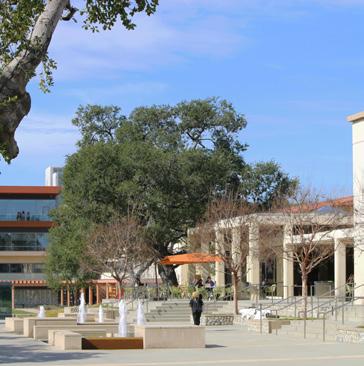

For Camille Forte CM ‘23, February’s ASCMC Resolution hearings have brought the entire ethos of CMC into question. Read more on page 10.
** No data reported
• THE STUDENT LIFE
Who knew Sixth Street was paved in gold? With P-P and CMS taking home six SCIAC titles in five of seven sports this fall, Claremont just laid witness to the 5Cs most dominant season in consortium history. Read more on page 12.
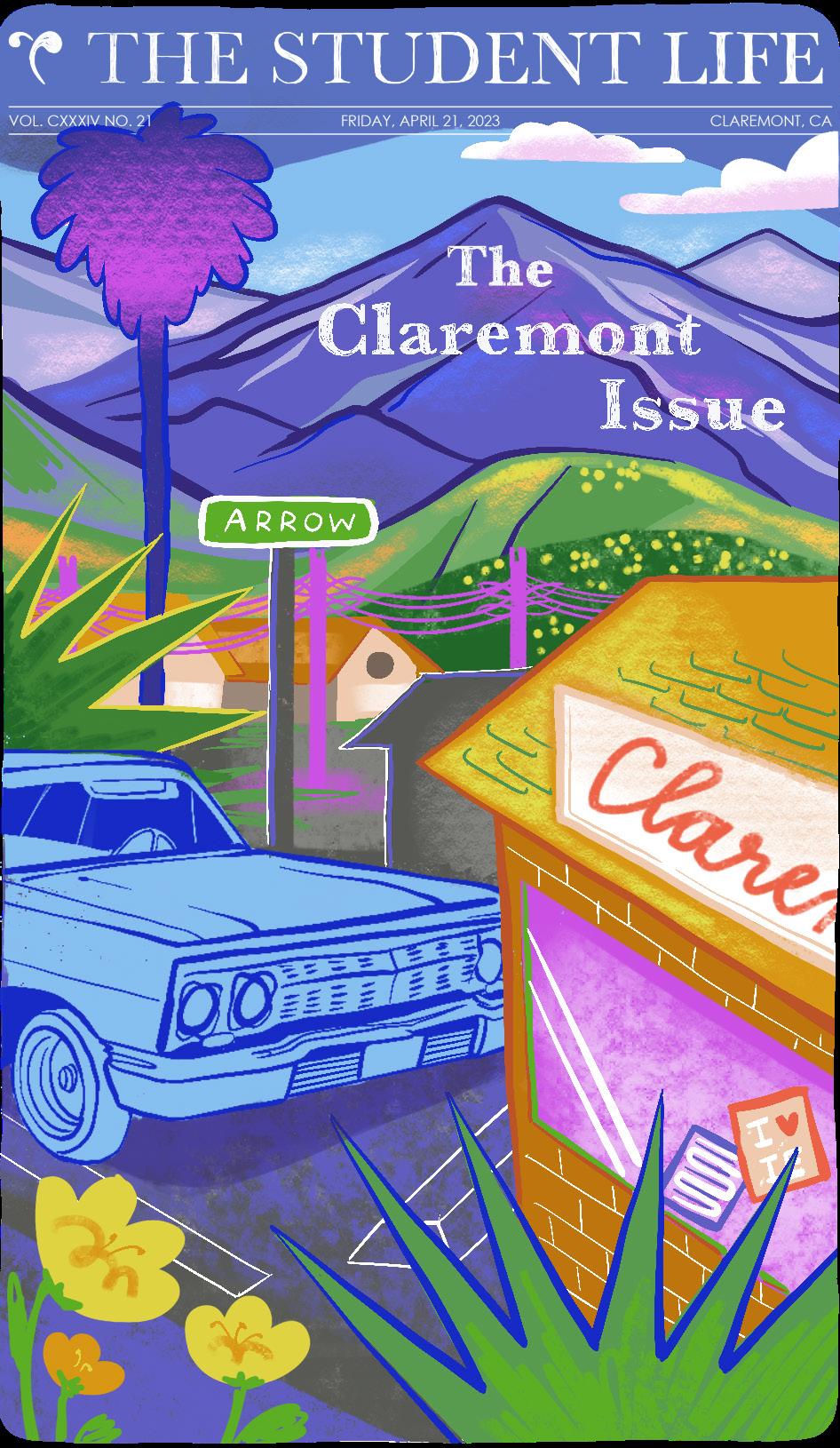

The student newspaper of the Claremont Colleges since 1889 INDEX: News 1 | Arts & Culture 5 | Special Spread 6 | Opinions 10 | Sports 11
& CULTURE OPINIONS SPORTS
ARTS
GUS ALBACH
PO HMC CMC PZ SC 0 25 20 15 10 5
+4 cases TSL COVID-19 Tracker covid.tsl.news from Apr. 8 - 14 Data from each of the 5Cs school’s testing dashboards at press time. Visit covid.tsl.news for historical data. ** HMC told TSL Oct. 10 that the school will no longer post case counts on a dashboard and instead will alert students via email when there is a surge in cases. at the 5Cs +3
** +0 +1 BELLA PETTENGILL
THE STUDENT LIFE
Student Staff Undifferentiated
•
Claremont City Council to vote
Tuesday on tenant protection ordinance
Following months of a temporary moratorium on renovation evictions in Claremont, a permanent ordinance focused on tenant protections will be reviewed by the Claremont City Council this Tuesday, April 25.

The temporary moratorium places a hold on no-fault evictions, in which tenants can be evicted through no fault of their own but simply because the owner seeks their removal.
The push for permanent tenant protections arose last year when residents of Monarch Terrace, an apartment complex in Claremont, faced eviction threats. These threats came due to a loophole in California tenant protection law that allowed landlords to evict a tenant on the grounds of renovation.
Tenants were protected by the Los Angeles County COVID-19 Tenant Protections Resolution, enacted on March 4, 2020, to provide tenants with certain protections regarding rent control, eviction and rent payments. Just over six months later, on Oct. 25, 2022, Claremont City Council extended the LA County tenant protections that were set to end in March 2023 and put into effect its own sixmonth moratorium beginning in January 2023.
Lydia Hernandez is a resident of Monarch Terrace and organizer of Claremont Tenants United (CTU). She expressed fear of what the future holds for those who face eviction.
“As far as I know, no one can afford to stay in Claremont who is threatened with eviction,” Hernandez said. “It’s just pushing people out of our community, and we’d like to be able to stay, and the way to stay is in the place you’ve secured.”
The tenant protections offered under this moratorium are pro-
posed as permanent protections under the ordinance for Tuesday’s meeting. Behind the ordinance are community groups CTU and Inclusive Claremont, a 5C-organized group in support of tenant rights. Gwen Tucker SC ’25 is the lead organizer of the group.
“My philosophy behind Inclusive Claremont is really just listening to what people in the city of Claremont need,” Tucker said. “So that’s why there’s kind of flexibility in terms of the issues that we work on because we
want to make sure that they’re what is most relevant and most impactful to the people who are actually experiencing struggles around affordable housing in Claremont.”

On Tuesday, the Claremont City Council will hear the ordinance and open up the discussion to public opinion. It will then discuss whether to amend, reject or accept the ordinance. The Claremont City Council is made up of five members, but only four council members will be voting on the ordinance due
Prison reform activist and author speaks on incarceration in LA
to a conflict of interest. Three votes out of the four will be required to pass the tenant protection ordinance. Both CTU and Inclusive Claremont have called for certain protections to be included in the ordinance. These protections include no-fault evictions, relocation assistance, rent stabilization, additional protections for vulnerable groups and limited exemptions on evictions. Though post-eviction relocation assistance is included in the ordinance, the focus is on
preventing these evictions in the first place.
“I don’t think [relocation assistance] is going to make a large impact. I think for people that have more means it will help them to find a place a little bit easier,” Hernandez said. “But if you can’t afford the rents in the area, whether or not they give you something to help with first and last month’s rent, that’s not going to help you meet your monthly obligation. That’s why keeping people in their place has to be the first priority.”
Scripps Associated Students appoints 15
board members for 2023-2024 academic year
ANNABELLE
On Friday, April 7, Scripps Associated Students (SAS) election winners were announced for the upcoming 2023-2024 academic year, after nearly 400 students voted in the election.
Newly elected SAS Executive President Lily Dunkin SC ’24 expressed her approval of next year’s SAS board. She is especially excited to collaborate with other officers to create change and build community on campus.
“My goal for next year is to foster a student body based on the values of community, action and accountability,” she said.
Dunkin, who is finishing her term as 2022-2023 junior class president, added that she decided to run for executive president because she wanted to expand upon her role in SAS and improve student experiences through various campus-based projects.
“I wanted to make sure that the amazing projects that are going on right now can continue and that we can create an even better community at Scripps,” Dunkin said.
Dunkin shared current measures in progress that will promote harm reduction, such as mitigating the responsibilities of campus security officers at events, encouraging peer-to-peer checkins, organizing water stations and holding Narcan training to help students prevent overdoses at the Claremont Colleges.
is looking forward to working with the other officers and improving the student experience at Scripps.
“I think that there are always changes that can be made,” Durre said. “It’s hard on an individual level, but I think collectively there are always projects and things that SAS is working on to improve the quality of life at Scripps. On a communal scale, [I’m] definitely looking forward to whatever initiatives are put forth by the group.”
TSL congratulates the winners and wishes them luck! The results are as follows:
SAS President — Lily Dunkin
Executive Vice President — Blessing Roland-Magaji
Vice President of Student Activities Melina Durre
Co-Treasurers — Isabella Guizler Bonilla and Reyna Manriquez
Secretary — Quinn Dwyer
Sustainability Chair — Raka Mukherjee
Diversity and Inclusivity Chair — Simran Sehi
Faculty Staff Relations Chair — Abbie Oh Arroyo
Judicial and Academic Review Chair — Kaitlyn Chen
5C Events Co-Chairs — Alex Hamilton and Sarah Paper
nialism in LA.
On Tuesday, April 18, Pomona College’s Ena H. Thompson Lectureship hosted Kelly Lytle Hernández for a lecture titled “Million Dollar Hoods: The Costs of Incarceration in Los Angeles.”

Lytle Hernández is a professor of history, African American studies and urban planning at UCLA. The MacArthur Fellow has written multiple award-winning books on race, immigration and mass incarceration. Her lecture at Pomona focused on her newest project, Million Dollar Hoods, which documents the human and monetary costs of incarceration in LA.
Her lecture began by exploring why LA is home to the largest jail system in the world. She attributed its vast size to the jails being used as a means of labor control.
“LA spend[s] money to round people up — but they’re gonna pay to do it. It comes at a deficit,” she said. She also added that excessive spending on the prison industry follows a history of settler colo -
”It’s known as ‘the Aryan city of the Sun,’ as California historian Kevin Starr calls it,” she said. “This is how they’re selling LA.”
With this in mind, Lytle Hernández arrived at her answer as to why LA has such a large prison industry.
“This is a story of mass incarceration as mass elimination,” she said. “Of course, it’s not just happening in LA, but LA is the iconic white settler city, so you see it intensely here.”
Adam Osman-Krinsky PO ’25 resonated with Lytle Hernández’s call for her listeners to get involved in the movement against mass incarceration and avoid “stay[ing] in the ivory tower.”
“She talks about community engagement and I believe it,” he said. “It’s really refreshing to be able to see a guest scholar, someone at the top of their field who you also know gives a fuck.”
During her sabbatical, Lytle Hernández collected 54 million data points from the Los Angeles Police Department (LAPD)
to inform the Million Dollar Hoods Project. In conjunction with the American Civil Liberties Union (ACLU), this data was later used to sue the LAPD.
“Talk about life goals, right?” Lytle Hernández said of her data research.
Near the end of the lecture, she invited the audience to participate in a movement tradition in which audience members say out loud the names of those whose lives were taken by the police. The audience repeated the names of 16 men who had been murdered at the hands of LAPD officers.
Lytle Hernández concluded with a reminder encouraging prison reform activists and students to care for themselves while supporting the movement.
“Care isn’t when we step away from the movement,” she said. “All the love and the care and the tenderness that happens inside the movement, that’s for me where the care happens, by leaning in deeper to those relationships.”

Blessing Roland-Magaji SC ’24, who previously served as first year class president and faculty staff relations chair, was announced as the new executive vice president. They were also enthusiastic about the prospect of continuing SAS’ work on current campus-wide projects.
“I’m most excited about being able to spearhead or continue projects of the past,” Roland-Magaji said.
Melina Durre SC ’25, who was chosen as next year’s vice president of student activities, said she
Student Organizations Commissioner — Rebecca Yao
Community Building Chair — Geeta Karlcut
Sophomore Class President — Celine Aoki
Junior Co-Class Presidents — Kimai McPhee and Anabhra Singh
Senior Co-Class Presidents — Destiny Rivera and Tara Zhang
PAGE 2 APRIL 21, 2023 News
JUNE HSU
ELLA LEHAVI • THE STUDENT LIFE
WENDY ZHANG • THE STUDENT LIFE
INK
CHASE WADE • THE STUDENT LIFE
elected their student body leadership for the 2023-2024 academic
Kelly Lytle Hernández spoke about mass incarceration and the prison-industrial complex at Pomona College. FIONA HERBOLD Scripps
students have
year.
In response to affinity groups’ demands, Chodosh says CMC may never fully realize values and commitments
On Thursday, April 20, Claremont McKenna College President Hiram Chodosh emailed the community with a response to an April 14 statement, authored by a collective of affinity groups including the Black Student Association (BSA), Sexuality and Gender Alliance (SAGA) and Asian Pacific American Mentoring Program (APAM). The statement calls on Chodosh, the Board of Trustees, ASCMC and the greater CMC community for increased institutional support for BIPOC students.
“We cannot thrive on CMC’s campus,” the affinity statement, which was addressed to CMC’s administration, says. “We are not valued at CMC. We are not heard or seen nor respected.”
In his response, Chodosh encouraged further communication
and stressed the importance of establishing foundations of mutual respect and understanding.
“I know that written words alone cannot fully address your concerns. Nonetheless, this response may help to inform both our direct discussions and effective remedies for the many issues you raise,” Chodosh said. “I am committed to working with ASCMC and you to enhance our joint communication and look forward to scheduling that opportunity to meet with you at your earliest convenience.”
The affinity group statement came three years after Chodosh’s announcement of the Presidential Initiative on Anti-Racism and the Black Experience in America, following the murder of George Floyd on June 18, 2020. According to the affinity group statement, the
goals outlined by Chodosh in this initiative have not been met by the college.The student statement condemns the college for performative allyship and for failing on-campus communities. It calls for increased social, financial and academic support via six specific demands:
1. Addition of a substantial Racial-Ethnic General Edu cation (GE) requirement
2. Creation of affinity group spaces
3. Increased financial support
4. Inclusion of board mem bers representative of BI POC students at deci sion-making tables
5. Increased affinity group funding
6. Support for Black interna tional students
The statement delves into
further detail for each demand, citing examples of a lack of institutional support such as the dissatisfaction of students, faculty and staff in the 2022 Higher Education Data Sharing Consortium survey.
“It is clear that [CMC] has, in very serious ways, regressed in its commitment to antiracism and service to its Black community,” the statement said.
Chodosh responded to the affinity group statement in a letter to the authors and wider CMC community. He clarified that he doesn’t respond to demands but will answer questions.
“The College is committed to removing any and all barriers that keep students, faculty, and staff from taking full advantage of and contributing to our mission,” Chodosh said in his statement. “This does not mean
we always satisfy, or can ever be fully satisfied in, the full realization of our values and commitments.”
Chodosh said the initiative, which began in June 2020, and the work leading up to it, have had a deep impact on the college. He said the COVID-19 pandemic hindered students’ abilities to feel these changes substantially on campus.
“Unfortunately, we were not in residence for the first 18 months of the initiative, and we lost a significant level of social memory and continuity that has been difficult to restore,” he said. “That has undermined the availability and retention of key information about the progress we have made and the work underway.”
Chodosh also rejected the affinity groups’ demand for the creation of safe spaces for BIPOC students in his email.
“The provision of dedicated, exclusive space for affinity groups is not a sustainable or effective response or solution to the source of the behavior that creates the underlying need,” he said.
Instead, Chodosh said there are plans to increase seating capacity in the CARE center, and that additional campus space in the Heggblade annex is available on a reservation basis. He also said ongoing, permanent student-centric space needs are under “constant consideration” in long-term master planning.
In response to the demand for a Racial-Ethnic GE, Chodosh said he shares the affinity groups’ sense of urgency in introducing these requirements, but said the Board of Trustees has rejected past proposals for being “insufficiently strong” and lacking a U.S. focus.
“Beyond the GE requirements, our introductory courses in economics, government, psychology and other disciplines have increasingly strong treatments of race and ethnicity in the US,” Chodosh said. “Beyond introductory courses, our majors increasingly ensure, as appropriate, the incorporation of learning objectives on a wide variety of social divisions within their requirements.”
CSWA demonstrations disrupt Pitzer’s Admitted Students Day, demand rehiring
NHI NGUYEN
On Saturday, April 15, members of the Claremont Student & Worker Alliance (CSWA) organized a series of demonstrations at Pitzer College’s Admitted Students Day. These demonstrations are the latest in CSWA’s campaign to demand that the college hire three former subcontracted dining workers who allege they were laid off due to their union support.
Stephanie Smith, Alexis Ongpoy and Kevin Ayala — known as the PZ 3 — were laid off by Bon Appétit Management Company (BAMCO), Pitzer’s subcontracted dining service, last December. CSWA has since organized a student campaign demanding that the college rehire the three workers. To advocate for the PZ 3, CSWA students have crashed Board of Trustees meetings, organized several dining hall boycotts and delegated to several administrative offices in the past two months.
As part of these actions last Saturday, dozens of CSWA members attended several scheduled Admitted Students Day events, where they talked to prospective students and their families about the campaign.
In the afternoon, CSWA also organized a rally at Pitzer’s McConnell Center Apron, right next to the outdoor dining area for admitted students and their families. At the rally, several student organizers, members of Pomona College’s dining hall union and members of the PZ 3 urged admitted students at Pitzer to contact the administrators in support of Pitzer workers.
“You are the voice that really counts, we’re the customers of this college,” one student speaker said to the crowd. “Everything you say puts pressure on the administration to get people with dependents, with lives, with incomes, with their own stuff going on, back at their jobs.”
The student urged prospective students to listen to workers and CSWA members about what being at Pitzer College was like, as opposed to the administration.
“[They] don’t experience what it means to be a student on campus. They don’t know what it is
to be a worker on campus,” the speaker said. “So why not ask the people who are here day in and day out, not the people who are here when it’s convenient to them.”
Smith, one of the laid-off BAMCO workers, shared her experiences working at Pitzer during the rally. She told those present at the event that while she was working at Pitzer, she made it her mission to make all the students she met feel at home.
“I’m here to take care of you and to make sure your parents know that you guys are good here at Pitzer [and] that comes from my heart,” Smith said at the rally. “But my heart wasn’t good enough when I put that [union] button on.”
To CSWA member Alex Pedroza HM ’25, the PZ 3 campaign is needed to not only alert future Pitzer students about the reality of the community at Pitzer but also encourage future Pitzer students to get involved even before they come to campus.
“I think getting admitted students and future Pitzer students involved in this fight from the get-go is really, really important in setting a precedent,” Pedroza said. “You can join this community and make a difference in this community before you even get to Pitzer.”
Caleb Quartey, a prospective Pitzer student who attended the rally, said he collected some of the stickers and pamphlets CSWA handed out during ad -
mitted students day.
“It seems like a lot of times, at least within this institution, the allocation of money is kind of unbalanced. And I think [it is]something that [Pitzer] should be more focused on,” Quartey said. “I feel like they can definitely pay [workers] more if they chose to properly allocate the resources, even if [they had] stopped the union from forming.”
Quartey also added that he thought CSWA’s campaign may have discouraged prospective students from choosing to attend Pitzer.
“I think that this demonstration probably turned a good amount of people off from the school,” Quartey said. “And I don’t know if that was really
the intent because, realistically, how are you supposed to create proper change?”
Pitzer Vice President of Communications Wendy Shattuck affirmed that the school acknowledged the demonstrations that had taken place that Saturday and that they were an essential part of Pitzer’s identity.

“Activism is a community value at Pitzer, and we respect the right of our community members to protest peacefully,” Shattuck said. “Caring, and voicing opinions, is part of the social responsibility emphasis and the very identity of Pitzer College, and we acknowledge those voices.”
Mariana Duran contributed reporting.
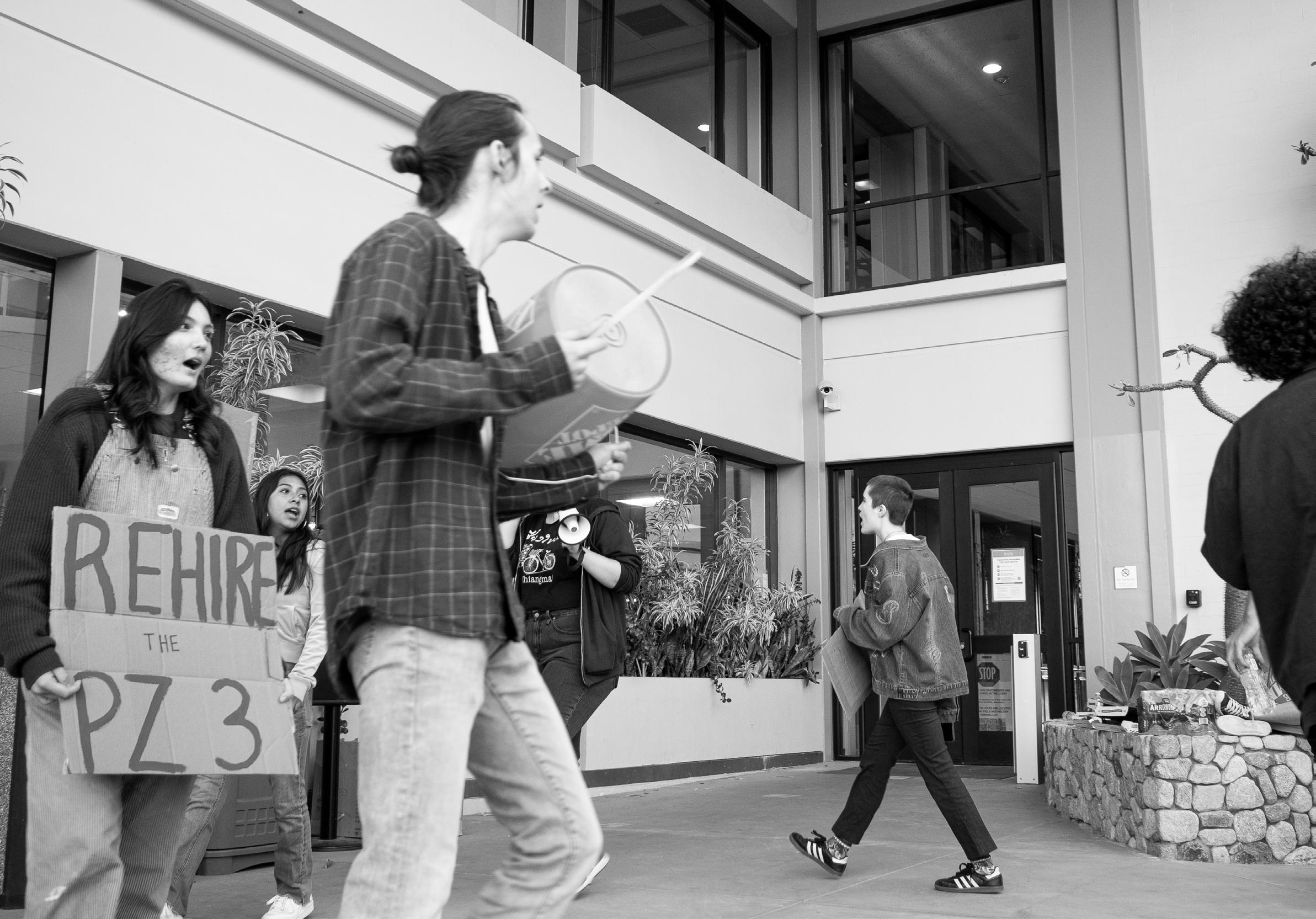
APRIL 21, 2023 PAGE 3 News
CSWA demonstrated at Pitzer College’s Admitted Students Day over the weekend. CHASE WADE • THE STUDENT LIFE
MAXINE DAVEY
WENDY ZHANG • THE STUDENT LIFE
President Chodosh released his response to affinity groups’ demands in an email to CMC students Thursday morning.
Q&A: Jed Leano on his time as Claremont Mayor and his State Assembly race

Claremont’s City Council member and former Mayor Jed Leano is running in the 2024 California State Assembly election for the 41st district. TSL interviewed Leano to ask him about the campaign, his goals and what the 7C community should know about him and his candidacy.
This conversation has been edited and condensed for clarity.
TSL: Why did you decide to run for State Assembly?
Jed Leano: While in public service, my effort has been squarely dedicated to the issues surrounding homelessness and housing. The crisis is continuously in steep decline. We only have so much time … to rectify it before we’re no longer able to meaningfully affect it. The need for leadership on housing is greater than ever. It was frankly an easy decision to arrive at because of the time and place of our housing crisis.
TSL: What has your career journey up to this point looked like?
JL: By trade, I’m an immigration lawyer. I intentionally used my law career as an opportunity to fight for and represent the most powerless people in our society: immigrants facing removal from this country. I felt compelled to pursue public service. There are deep seated policy issues. I not only want to change what we do about them as a matter of policy and practice — I also want to change the way we talk about these things.
TSL: Do you have greater political aspirations? What do you hope to do after the State Assembly?
JL: I’m driven by a mission to directly impact homelessness. The number one way to impact homelessness is the production of housing … I don’t view this race as a next sequential step in the journey for me as an individual. I see this as a natural step to fulfill my calling to utilize my opportunity in public service to pursue the greater good and help house all Californians.
TSL: Tell me about your time as Mayor of Claremont. What key lessons or practices did you learn? How has it informed your work as a politician?
JL: My time as mayor was a really difficult period, Factors far beyond my or your control have made trust in government really hard. The only way to win that trust is to deliver for people. We have to show people that there are good people in government who really want to serve, help and solve problems. We can only win people’s trust by showing that that’s our motivation and then delivering on that motivation.
The big lesson that I learned is that you can think through all of these policy problems all you want. You can formulate plans. You can vet them with a team of professionals. [But] sometimes, people just need you to be there for them. They don’t need you to have the right answers all the time.
TSL: What are you most proud of in your record of public service?
JL: Unquestionably it’s a record that’s substantially around policy and housing. Right after I got elected we instituted our homeless services plan … We built a homeless services delivery infrastructure that helped us reduce homelessness by 41 percent by our second year … I’m elected to the board of the new LA County Affordable Housing Agency, so Claremont is on the map as a regional leader on the issues of homelessness and housing policy.
In 2021, we approved a transit-oriented district, which is going to be our largest housing development in the history of our city [and] go very long ways in reducing our carbon footprint.
We amended our inclusionary housing ordinance so that for the very first time, people who are building homes in our city will include low income housing units. I have put an immense amount of effort into making our city one that gets housing policy right, and I look forward to doing that at the state level.
TSL: What makes housing so important to you?
JL: My father grew up in Tondo,
Manila, one of the poorest neighborhoods in Asia, and lived in public housing. I had a mother who worked nights at a hospital, and my father is an engineer, and he worked overseas for most of my childhood. So I was raised by my grandmother, and in the last 20 years of her life she lived in subsidized senior housing. So, when I hear rhetoric that “housing for people in poverty will bring crime and drugs and danger to our neighborhoods,” it’s very personal to me. People like my father and my grandmother need somebody to stick up for them, and very often there’s just no one to fight for them. When you get housing policy right, you get social justice and equity policy right. The original sin of this country is slavery, and when we got rid of slavery, and then undid segregation, we continued to separate people legally by housing laws … so that people of color stayed out of wealthy and white neighborhoods. And we did that legally for decades. When you get housing policy right, you get climate policy right. Good climate policy matches housing production with transportation amenities, with jobs and with infrastructure … When you get housing policy right, you get transportation policy right … And finally, when you
get housing policy right, you get education policy right. If families with young children cannot afford to live in cities, those cities will close schools … So housing policy encompasses everything else.
TSL: Would you encourage college students to get involved with politics and public service?
JL: They absolutely should … if they don’t, for the most meaningful decisions that impact basic questions, they will not have a seat at the table … We cannot allow housing policy to be made by the people who are not impacted by the crisis. We have to make sure that the people who are facing the brunt of the crisis have a central voice and a champion.
When I first ran for City Council in 2018 … I had students run my campaign. I got to know a bunch of students at the 5Cs because of my immigration advocacy and volunteerism. And when I decided to run for City Council, I went back to them and I said, “I don’t just want you to volunteer in my campaign, I want you to lead it. I want you to run it.” And after we won, I didn’t want to just say “thanks a lot. I’ll see you again in four years,” I want-
ed to bring them with me. I wanted them to learn what I learned … And from that I have just built this remarkable bench of young people who’ve gone on to Rhodes Scholarships, law schools and national campaigns during the presidential election, and I always welcome new students to be a part of this incredible journey.
TSL: Do you have anything else you want to add or that you think is important for the Claremont Colleges community to know about you and the campaign?
JL: None of this happens without the help of students that I had with me along the way. I feel a remarkable obligation to give back to the students who attend the Claremont Colleges because without them I would never have been a City Council member, I never would have built affordable housing in Claremont, I never would have built a homeless services infrastructure and I never would have risen to the Chair of San Gabriel Valley Regional Housing Trust … I owe a lot to these campuses, so I want to continue to pay it forward,give the opportunity to be involved in politics and make sure that this campaign is a home for any Claremont Colleges students who wish to be involved.
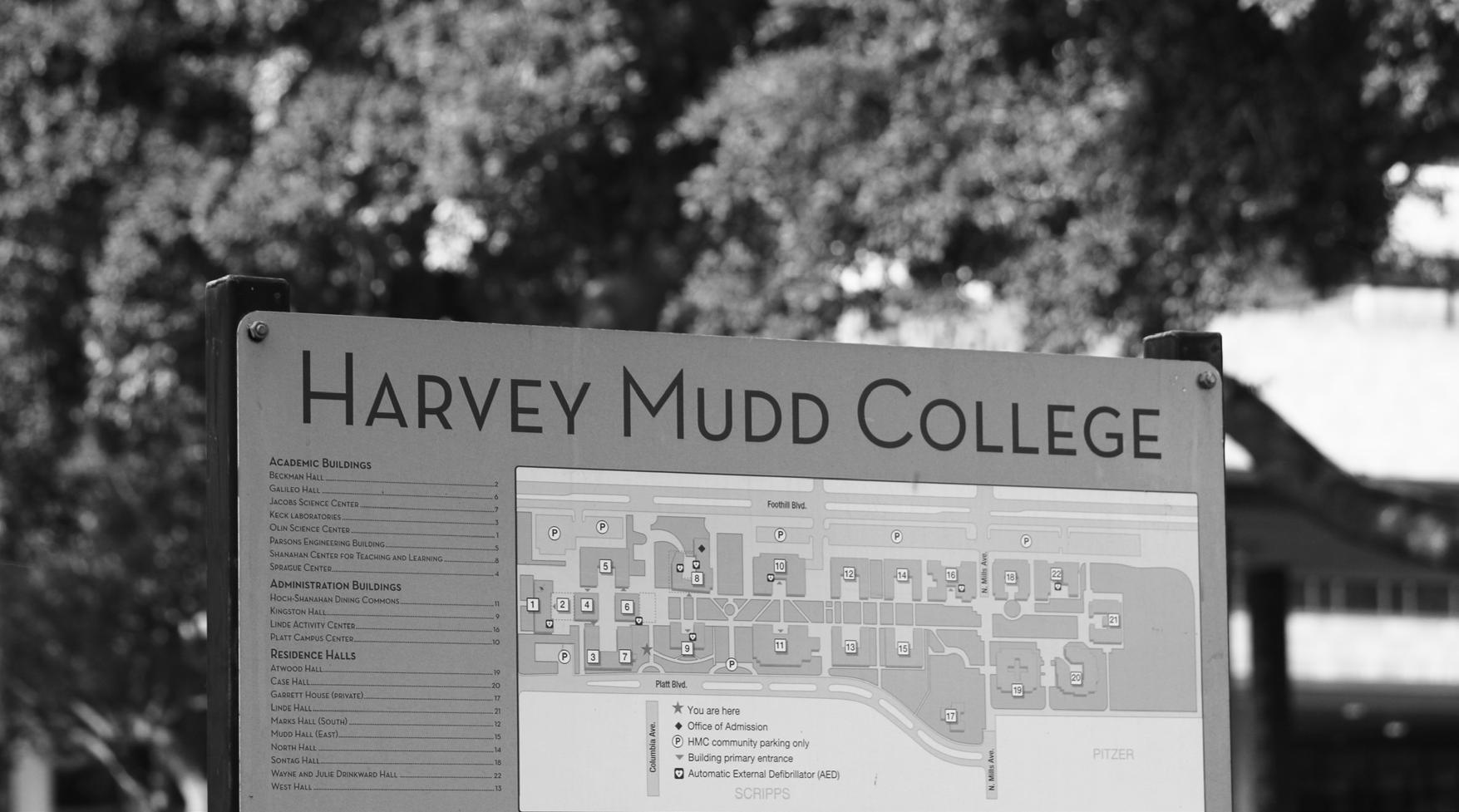
Hannah Dearman-So HM ’25 receives prestigious $65,000 engineering scholarship
This year, the American Council of Engineering Company (ACEC) awarded over $65,000 to exceptional graduate and undergraduate students whose work demonstrates their interest in California-specific issues. Hannah Dearman-So HM ’25 is among the recipients of this prestigious scholarship.
Dearman-So, an engineering major from Ventura, California, was shocked when she was notified of her achievement because the application seemed focused on students pursuing graduate degrees.
“I was doubtful, but I had shown a lot of interest in consulting engineering fields, so I thought maybe I had a chance,” she said.
Dearman-So said her practice writing other scholarship essays made her a competitive applicant for the scholarship, as well as reviewing her materials with people who helped her highlight important personal characteristics. She also said her scholarship reward will help pay for Harvey Mudd College tuition. “I’m always on the hunt for scholarships,” Dearman-So said. “The 5Cs are very expensive.”
This summer, Dearman-So will be part of a team of five students at HMC doing industrial manufacturing engineering work as part of the Riggs Fellowship. They will serve as a consulting group and tackle specific problems for local manufacturing companies, such as
improving production efficiency through inventory reduction.
“I am really excited about this program in particular, because you can do a lot of summer research and internships where you’re part of a more ongoing project, right? This summer, I really wanted
something where I could start, finish and see my results,” she said.
Dearman-So shared that she has been interested in science, technology, engineering and mathematics (STEM) for many years and chose HMC because
of its collaborative environment and focus on integrating humanities into STEM curriculum. She added that although the classes and projects at HMC were difficult, they were rewarding. One highlight of her experience was building an underwater autonomous robot to measure for algal bloom conditions.
“Knowing that my education is not only making me more empowered but also making a broader positive social impact on my community and beyond is my favorite part,” Dearman-So said. “The Mudd mission statement is a bit cliché, but I’ve really come to resonate with it.”
Dearman-So says she’s in the “calibration phase” and doesn’t know exactly what she wants to do in the future. However, she envisions staying in the engineering world and hopes to pursue a career that is team-oriented and has a lasting impact.
Dearman-So is not afraid of some uncertainty, and she advised other students not to let their self-doubt stop them from pursuing opportunities.
“The worst they can say is no, and then you’re just back where you started,” she said. “It really doesn’t hurt to try, and it will surprise you a lot of the time.”

PAGE 4 APRIL 21, 2023 News
JULIA SCHWARTZ
LUCIA STEIN
WENDY ZHANG • THE STUDENT LIFE HMC sophomore Hannah Dearman-So is a recipient of the American Council of Engineering Company scholarship.
Former Claremont Mayor Jed Leano is running for California State Assembly.
COURTESY: JED LEANO
5k Dream Run provides footing for undocumented students
The annual 5k Dream Run is set to make a comeback at 10 a.m. on Sunday, April 23 at the Pitzer College clock tower after a four-year hiatus. Hosted by 5C organization Improving Dreams, Equality, Access and Success (IDEAS), the run is a community-building event that serves as a means of generating mutual aid funds to support undocumented students in their academic pursuits.
Verrels Eugeneo PO ’25, one of the six IDEAS board members, described the importance of the mutual aid fund.
“[Within] the experience of being undocumented, there are situations where you might not have the money to travel home if there’s an emergency. There are also fees in
in the Claremont community, there’s a lot of wealth and there’s a lot of privilege, but you can still do your part and create a positive impact by listening to the struggles that people have that aren’t in the same privileged positions.
Verrels Eugeneo PO ’25
case you have to pay for your DACA [Deferred Action for Childhood Arrivals] renewal and things like that,” Eugeneo said. “There are a lot of issues that can be mitigated using the money we raise.”
IDEAS organized the event with the support of Pitzer Assistant Dean of Student Success Tasmia Moosani, 30-plus student volunteers and additional 5C faculty members. The organization’s primary aim is to promote and aid immigrant students in their academic pursuits by facilitating access to networking platforms, financial aid and essential resources. Kassandra Soriano Martinez PZ ’25, IDEAS board member, highlighted legal resources as an example.
“If anyone ever comes to us for help with legal matters, oftentimes we can refer them to certain people at their colleges that can help … we have a lawyer that students can use,” Kassandra Soriano Martinez said.
This run will mark the end of UndocuWeek, an IDEAS initiative that promoted networking among undocumented students and improving allyship. Jose Sanchez PO ’24, IDEAS board member, described the renewed significance of UndocuWeek.

“A lot of the events specifically focus more around rebuilding the community of the undocumented students on campus, which has kind of just spread out over the years, especially with everything being on Zoom, and [they also help with] how scary it may be to reach out to other people who … may be undocumented,” Sanchez said.
Since the run hasn’t taken place since 2019, IDEAS has had to re-envision and reconstruct the event, thinking about the event’s role in the community as well as intricate logistical concerns.
“I’ve held this project really close to my heart, and I’ve been working on it all year, since the start of last semester,” Kassandra Soriano Martinez said. “We hope that this remains a tradition. That’s something that I’m working on heavily: to try to log everything, make records of everything, so that it runs more smoothly in the future.”
The post-run celebration will include a local taco vendor, food trucks, live music and a raffle with an electric scooter as the grand prize.
“We’re providing free food, not only in the hope that it’s incentivizing people to show up, but also as a way outside of the run for people to gather after the event,” Sanchez said. “And as a way to build that community and talk with each other and build off of each other.”
Cultivating an environment that supports undocumented students goes beyond the 5Cs. With a wider reach that encompasses local community colleges, universities and high schools, the run will bridge
a broad spectrum of perspectives outside of the Claremont bubble.
IDEAS board member Angeles Soriano Martinez SC ’25 highlighted the necessity of spaces for undocumented students.
“Whenever I would go on high school tours and ask about the resources that they had in their specific campus for undocumented students, a lot of people weren’t sure because they either never had to use those resources or there were no resources,” Angeles Soriano Martinez said. “Creating visibility and bringing moral support does have a big impact on the way that high school students who identify as undocumented see themselves in these spaces.”
Moosani hopes local undocumented high schoolers will witness firsthand the efforts to support them in an institutional context.
“We want them to come to the 5Cs and [communicate to them,]
‘Hey, we hope you apply here. We hope this is a space where education can feel accessible. We hope that you can also feel that inspiration that you can do it too. And we’re here to help you through that if you have any questions or need any financial support,’” Moosani said.
As allies of undocumented individuals, monetary support is important, but showing up for the run, cheering on community members and listening to undocumented students and DACA recipients is equally important.
“There is quite a bit that goes into being an ally for anyone,”
IDEAS board member Luis Mendoza Ramirez CM ’25 said. “We particularly believe that even just showing up to the dream run or even just donating and being there
with us is a very good first step for anybody who wishes to learn more about being an ally.”
Sanchez agreed with Ramirez.
“It’s an event that involves the whole community, not just undocumented students,” Sanchez said. “For it to be successful, it’s required to be supported by everyone.”
This run will pave the way for increased visibility and both institutional and communal support for undocumented and DACA students.
“In the Claremont community, there’s a lot of wealth and there’s a lot of privilege, but you can still do your part and create a positive impact by listening to the struggles that people have that aren’t in the same privileged positions,” Eugeneo said. Race registration and more information can be found on the @ideasclaremont Instagram page.
So You Want to Dress: Streetwear
LISA GORELIK
Were you also a victim of the 2016 hypebeast era? Have you been influenced into overpaying for a T-shirt because it had an exclusive brand logo? Did you watch endless YouTube videos on how to beat the buying bots on the Supreme website? If so, you may be entitled to emotional compensation, and you are not alone.
Streetwear fashion first emerged in the hip-hop community in the late ’80s before being adopted into red carpet fashion in the ’90s. With the rise of nu-metal music and skater culture in the early 2000s, streetwear shifted from its original bomber jackets and flat caps to below-the-knee, ultra wide shorts and tank tops. Rising up from the more niche, authentic skate community, skate brands such as Supreme and Palace Skateboards took over the streetwear scene in the mid-to-late 2010s.
Although streetwear fashion originated in small communities centered around music, surf and skateboarding, as well as prioritized practicality and comfort, it has recently become one of the most exclusive and elitist fashion communities. Streetwear is no longer about underground communities rebelling against the mainstream; now, it is all about trends and the brand name. With the never ending amounts of brand collaborations between streetwear brands and luxury labels — such as Supreme x Tiffany & Co. or Supreme x Louis Vuitton — streetwear has become unaffordable and inaccessible to the wider public.
Supreme has almost completely sold out all of its brand values with their rise to fame. Many skater brands such as Supreme started out as small businesses who catered to the needs of professional skaters, such as making durable and protective clothing specifically for skating. These standards and the quality of items that professional skaters were looking for have now been lost due to the fetishisation and absorption of skater brands by the luxury sector — by people who have never even picked up a skateboard. Although I cannot speak from the perspective of a professional skater, I would surely be disappointed and feel as if a brand that I had been a loyal customer to over many years failed me. These labels abruptly became inaccessible for the customers that needed them most, both in terms of skyrocketing prices and because of the lack of stock available for sale.
Fashion fanatics now spend quadruple the retail price to ac-
cess these limited items, just to be able to sport a recognizable, exclusive brand logo. Because of this label obsession, streetwear has lost its appeal to the younger audience who cannot afford these pieces, but we are now thankfully leaving this era behind and returning to streetwear as it used to be.
Today, streetwear fashion has been readopted by the skater community and popularized by the wider fashion enthusiast audience. Streetwear is returning to its roots, with most on trend pieces being available in thrift stores and resale apps for a fraction of the original price.
So let’s talk about how you can resist the cringey and outdated hypebeast fashion by tapping into your authentic skater or streetwear look, no skateboard required.
The first staple that you will need for a modern streetwear look is a pair of baggy Dickies, Carhartt utility work pants or chinos. Or in case of a streak of warm weather, opt in for a pair of denim or camo cargo shorts. As for the top, you could go with a Harley Davidson hoodie or an oversized graphic T-shirt. Add a gray fisherman vest for extra utility pockets if needed. For accessories, a beanie never misses. And wear rings: bulky silver ones on all ten fingers. If your ears are pierced, definitely add a statement earring or two, and get as many chain necklaces around your neck as possible. And if you are going for baggy trousers, a black studded belt is your friend. As for the shoes, you most likely already have a pair to go with your outfit in your posses-
sion. Grab those trusty old Vans or Nike Air Forces, and you’re good to go. Or if you want to switch it up, invest in a pair of solid color Nike Dunks or Jordans — the price tag is high, but buying second hand is also always an option!
As with my hair tips in my previous articles, I have to advocate for the mullet haircut yet again. It is the most versatile haircut out there — it works with both feminine and masculine styles and is perfect for both curly or straight hair. This is your sign to get that mullet!
If you were someone that bought into the hypebeast trend, don’t beat yourself up; it happens to the best of us. But now with the return of more authentic streetwear, definitely stop yourself before spending crazy amounts of money on a hoodie

JOANNE OH • THE STUDENT liFE
or a T-shirt and ask yourself: Why are you really buying this? Is it for the brand name, the exclusivity, and the acceptance? Or do you actually like the item and think that it would be a great addition to your closet?
Streetwear doesn’t have to be so expensive and elitist, but the only way that we can move the trend away from those leanings is to stop buying into the consumerist culture that is constantly pushed upon us. You don’t need outlandish clothing items to be a part of the streetwear community –– keep it original and be you. Don’t buy into a culture that aims to exclude people on the basis of class.
Elizaveta (Lisa) Gorelik CM ‘25 is from Moscow, Russia. Her favorite part of the day is taking time to get ready in the morning whilst listening to some nostalgic tunes.
April 21, 2023 pAGE 5 Arts & Culture
ZHAN
MAYA
COUrTESY: VErrElS EUGENEO
Students are running to raise money for undocumented students at the Claremont Colleges.
The ClaremonT Issue
Editor’s Note












As this spring semester wanes and the 7Cs inch closer toward the summer, we here at TSL find ourselves increasingly reflective of our work and legacy in Claremont. In our own introspection, we want to recognize our tendency toward limiting our storytelling to the 7Cs, instead of the greater city. In that spirit, we hope to be the change at TSL that we’d most like to see and burst the bubble.
While we acknowledge that some of our readers may be active in the Claremont community outside of our own, we also recognize that many of us may not be. To that end, we have spent weeks collecting the artwork and preparing the stories for this spread, in hopes of incentivizing you to immerse yourself in the communities just beyond Bonita Ave. Whether that be traveling to Mount Baldy in search of higher altitudes or walking an admittedly shorter distance to Laemmle Theatre in search of an even better movie, we hope our special Claremont issue will inspire active gratitude.
But you don’t have to seek this kind of community outreach alone, there are many opportunities that the 5Cs offer to interact with the community.
Look out for the poppy icon next to articles with a special focus on the off-campus Claremont community!
We urge you to just take advantage of them. You can even accomplish this goal while also earning credits. Pitzer College offers the four-course-long Critical Action & Social Advocacy (CASA) program, which “advances critical analysis and community partnerships around the most pressing issues in the Inland Empire.” Leadership in Environmental Education Partnership (LEEP) connects college and elementary students to hands-on environmental education. Inside Out offers multiple courses per semester where 7C students can learn alongside incarcerated students at a men’s prison in Norco. The list goes on.
That being said, we find it paramount that in this conversation of mindfulness in our community, we encourage our readers and remind ourselves to participate in these outreach programs for the right reasons. Let the relationship between us and the greater Claremont area be one of reciprocity, compassion and authenticity. In this way, we hope to continually exercise appreciation without co-optation of our community, and encourage our readers to earnestly do the same.
It is easy to forget how our small community fits within larger ones — the city of Claremont, the Inland Empire, Southern California — but it’s important to be aware that we are not an island. Our campuses are integrated into a web of living, vibrant communities. We would find it wasteful of our limited time here to live and work at the 7Cs without treating our greater neighborhood with appreciation and curiosity.
— Editorial Board TSL’s editorial board is comprised of its editor-in-chief and two managing editors and does not necessarily represent the views of other TSL staff members.
What do you love about the natural environment where you live?
Local fifth-graders answer



“A bird is flying, a squirrel is roaming. Life is great, life can cause hate. Hate is bad, life can be sad. Trees oh trees such wonderful things, trees oh trees all full of green.”
“My drawing is my favorite tree. I think this tree is amazing because when it has not bloomed yet it looks ordinary but when it blooms it looks so unique and nice.”

“My favorite part of the Bernard Field Station was the lake. The tadpoles were SO cute, and the lake was crystal clear!”
“I don’t live here, but I live in a nearby apartment, it doesn’t have much natural stuff, so I drew the neighborhood I live near because of the front yards. They always have beautiful flowers or cactus, trees and all that stuff. And I love how pretty the flowers and trees are.”
“Big tall palm trees are all around where I live.”
“In my front yard I have three nice palm trees. We also have a brick planter for them. I drew this because when there’s wind I like the way they sway left to right.”

“My drawing is about the superbloom and I pass it on my way to my grandpa’s house.”

“When I come home from anywhere I see these awesome mountains.”
“I picked to draw a tree because trees do a lot for us, they make the bad air into good air for us to breathe.”

Oakmont Elementary School fifth-graders’ drawings, combined


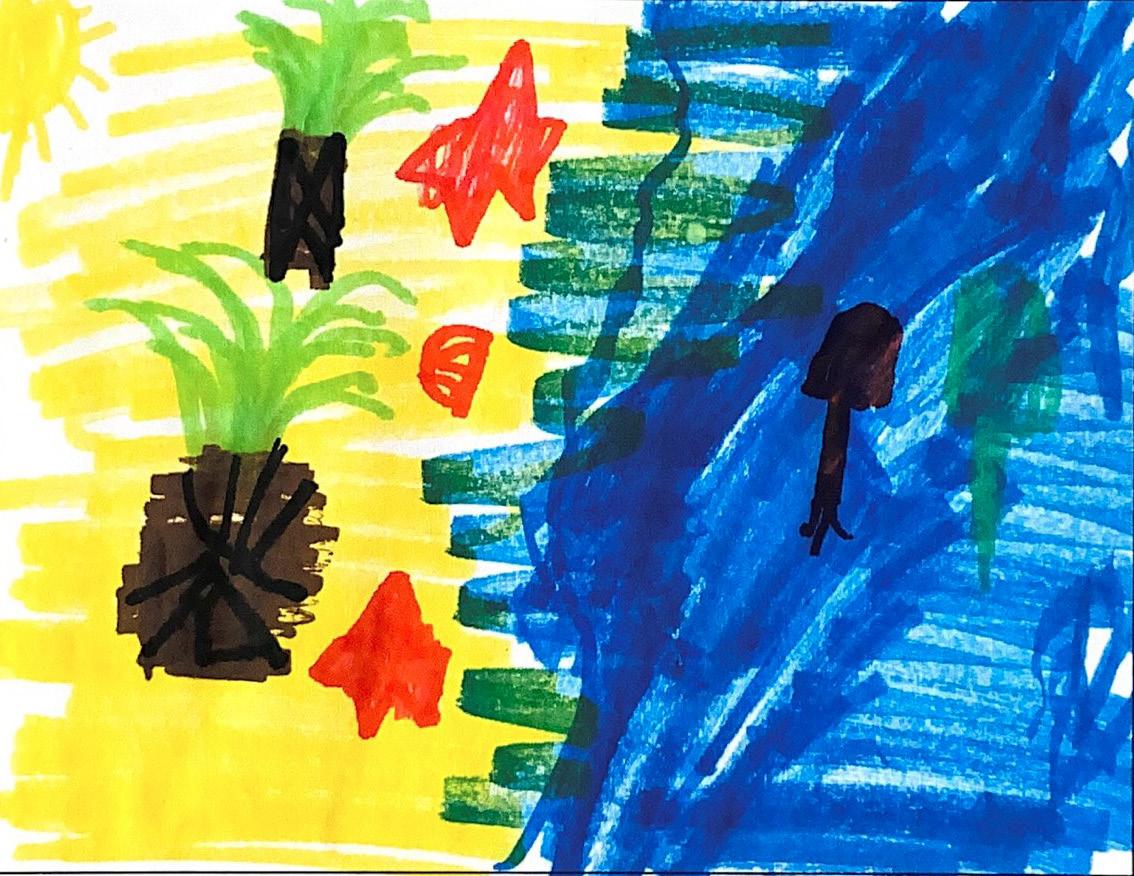

“I love the tall sycamore tree in my backyard. It’s very tall and sways in the wind. I like to climb it. Almost every day, I see at least 10 birds in the tree with squirrels. Once in my backyard near the tree, in a trellis, there was a bird nest in it with a baby bird!”
“I live where there are lots of evergreen trees and buses, also I live 20 minutes from the mountains.”
“I love riding my bike in the rain.”
“It is coastal, with the animals in the water, the palm trees swaying, the waves rising, the water flowing, the sunny sky, the warm sand, also known as the coastal area.”
“I love all the little plants that grow in the spring.”
To fulfill my natural science GE, I enrolled in Outdoor Science Education this semester. The class meets twice a week at the Bernard Field Station just north of Foothill Boulevard, once to learn ecology concepts and another to teach those concepts to local fifth or sixth graders, through a program called Leadership in Environmental Education Partnership (LEEP). My lab group was partnered with roughly the 40 fifth graders of Oakmont Elementary School, who have brought a sense of wonder and excitement with them to every class. I have loved seeing the ecology of Claremont through their eyes. On the final day of instruction, I asked the students to share their favorite elements of the natural environment. We’ve chosen to highlight what our youngest community members think about Claremont through their artwork and responses to the question: “What do you love about the natural environment where you live?”
Hannah Weaver, Editor-in-Chief
PAGE 6 APril 21, 2023
Faces, places, spaces: A photo spread
To express our endless gratitude for the faces, places or natural spaces that comprise the Claremont we know today, our staff has chosen to share some of our favorite moments from beyond the gates.The collection of photos included in this spread demonstrate what immersion and the fullest appreciation of our community can look like. It’s our deepest hope that these photos may inspire exploration, excitement and eagerness to learn from the world just outside our 7C campuses.
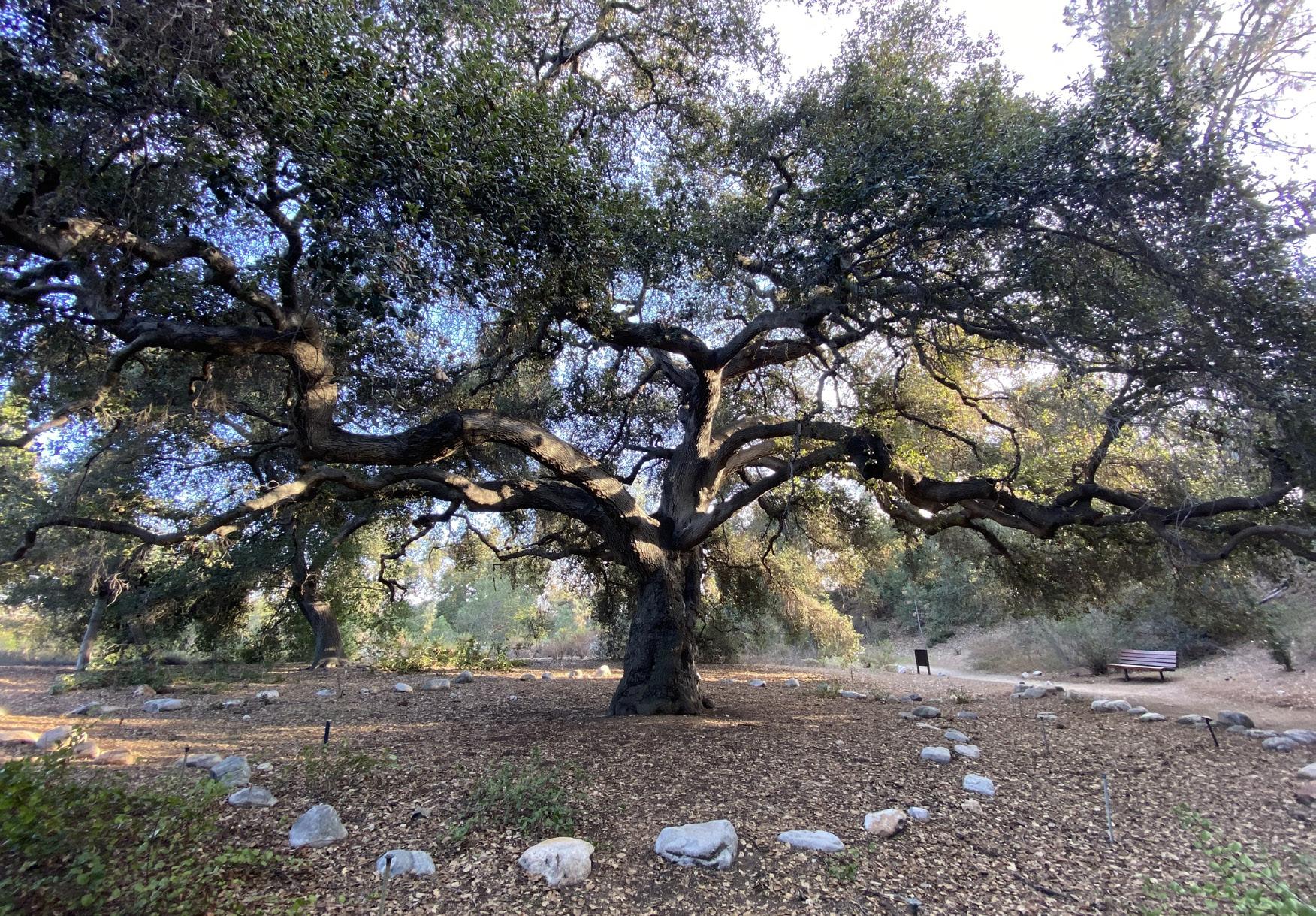


OPINION: Stop calling it the ‘Claremont
Hi!

BELLA PETTENGILL
Within the rhetoric about on and off-campus communities, there is an impulse to reduce the one total square mile of the consortium to simply, the “Claremont bubble.” This urge to paraphrase, however, only reifies the belief that the 7C campuses are far removed from the communities that they are situated within.
There is a problematic tendency from Claremont Colleges students to only look inward over the course of their college career or to derive one’s life from the performance of school. In conversations with friends from different states or countries, I have noticed a resistance to engage with people and spaces that are not strictly associated with the Claremont Colleges. It is not uncommon to meet a student that does not know their neighbors, their street names, the surrounding cities, local restaurants or community events.
After I was accepted to the Class of 2024, Pomona College let me know that I was one of 16 within my class that lived within a 47 mile radius of campus. As a proud 1/16 of the Inland Empire “locals,” as we’ve been dubbed, I am disheartened to find fear, disinterest or inaccessibility holding back my fellow students from engaging with the spaces I have grown up around. The “Claremont bubble” is entirely constructed by students whose lives revolve solely around this institution.
As someone that constantly pivots between a home and campus life at a non-commuter school, there is a misunderstanding between me and my peers about our priorities. It is easy to get lost in the politics of Claremont life, but these dynamics become irrelevant with the perspective of my entire community.
The colleges bleed into the space around them. Only a few minutes walk away are restaurants, local businesses, schools and homes. A few minutes drive
away, there are several other college campuses. These communities know little about the colleges aside from the space they occupy midtown, and a majority of Claremont students know little in return.

While I understand the difficulty of transportation within Southern California and recognize the inaccessibility of even local travel for many Claremont students, I’d argue that a change in perception, rhetoric and general mindfulness is universally possible. I urge current students, especially underclassmen, to take the time to recognize their positionality within these spaces and offer their time and consideration to the surrounding communities. Programs like Upward Bound Tutoring, the Draper Center, the Napier Initiative at Pilgrim Place and Community Partnership courses provide opportunities for students to get involved, all of which include transportation support. Through action, the mental lines drawn in the sand between campus and off-campus dissolve. The conceptual “Claremont bubble” loses its foundation.
If these perceptions of an immediate, powerful on-campus and a vague, irrelevant off-campus are to be deconstructed, one must consider the effects of their rhetoric and the processes by which a personal understanding of positionality can come to fruition. If you are to live in a place for four or more years, consider, what have you exchanged? What have you learned from its communities and what have you brought to it?
Students do not live in a bubble; they interact with members of the Inland Empire community daily: their dining hall workers, custodians, administrators, professors and so forth. Families, identities, careers and policies are constructed outside of the Claremont Colleges’ private institution. Have conversations about these disparities, and put yourself in the places to have these conversations.
Bella Pettengill PO ‘24 is from Chino, California, and studies Studio Art and Cognitive Science. She wants everyone to touch grass.

JJ’s Crossword

17.New Pitzer and Scripps science center, coming Fall 2024
18.Abbr. for Pomona org. that collaborates with high school students to enjoy na-
for
Spring
ture and discuss mental health
DOWN
1.You might have projects, exams or essays when classes are finished
2.____ Claremont, 5C club supporting tenant rights
3.Jed ___,Claremont City Council member and former mayor, running for California State Assembly 4.The day that TSL is published and distributed
6.This month’s rain supposedly brings May flowers
7.Cornel who recently spoke at the Ath
8.Storyteller’s ___, recent PZ event focused on sharing stories, music, art and food

9.Pomona student organization whose elections recently concluded
11.Two days that only come once a semester 12.Claremont tennis club
13.Studio at Harvey Mudd where students can learn new skills with others
APril 21, 2023 PAGE 7
bubble.’ You’re only making it real
EMMA CONSTABlE • THE STUDENT liFE
Happy Earth Day!
ACADEMiA NUTS: A COMIC BY ELLA LEHAVI
JJ HOFFMAN • THE STUDENT liFE ACROSS 5.5C men’s ultimate frisbee team 10.Thankfully, graduating students don’t have to do this 14.Thompson ___ Trail; 2.8 mile trail in Claremont 15.Mountain north of Claremont 16.Scripps Coffeehouse
I’m JJ, and I was the puzzle apprentice
the
2023 semester. This is my crossword puzzle integrating some TSL stories as clues. Continue on the next pag e for Jasper’s puzzle!
The Claremont l ewis Museum of Art is located in the historic Claremont Depot, aside the train tracks. Grace Sauers SC ’23 walks a friend’s dog along the trails of Claremont Wilderness Park.
Megan Maley SC ‘23 takes a mid-run rest in the hills of Claremont Wilderness Park.
Averi Sullivan PO ‘23 and Melat Feseha PO ‘23 embrace at a lookout on Mt. Baldy.
The California Botanic Garden houses what they call the “Tree of l ife,” along with many other plants native to Southern California.
COUrTESY: rEM riNN
AVEri SUlliVAN • THE STUDENT liFE
HANNAH WEAVEr • THE STUDENT liFE
HANNAH WEAVEr • THE STUDENT liFE
HANNAH WEAVEr • THE STUDENT liFE
Author Karen tei Yamashita’s quest to preserve family history
When asked to be a guest speaker for a high school assembly last year, Karen Tei Yamashita, author of “I Hotel” and the recently published “Sansei and Sensibility,” decided to bring joy back into the students’ lives.
On April 13, Scripps Presents invited renowned author Karen Tei Yamashita, a recipient of the Lifetime Achievement Award for Distinguished Contribution to talk about her works in Balch Auditorium. Yamashita is a finalist for the National Book Award as well as a recipient for the U.S. Artists’ Ford Foundation Fellowship. She is currently a professor emerita of literature and creative writing at UC Santa Cruz. Yamashita was in conversation with Jean Chen Ho, Scripps’ 2023 Mary Routt Endowed Chair.
“Karen’s impressive bonding of work includes novels, short stories and essays … She works in what literary critics call historic fiction, magic realism and social-political satire,” Ho said. “Through it all, Karen writes with a sly-sardonic sense of humor and a vast intellectual curiosity about the absurd world we live in. Reading her work teaches us to see carefully [and] compassionately into the concerns of the human heart and the radical hope that keeps it beating day after day.”
Her newest book “Sansei and Sensibility” is a collection of short stories and essays filled with humor,
emotion and revelation about a cross-country roadtrip Yamashita took with her niece from Providence, Rhode Island to Los Angeles, California. Throughout the trip, the two women stop by several Japanese incarceration camps to learn more about their family history and heritage during World War II.
“Every museum and its collection is different and yet the same — same as in the urge to preserve, to store stories and to teach. They curate stories, a vision and aversions of events and truth,” Yamashita explained during her reading of the chapter, “KonMarimasu,” which directly translates to “I’m in trouble” in Japanese.
“Each of those remote sites of Japanese incarceration — their monuments, interpretive centers, museums and people all describe the racism, hatred and fear that unjustly imprisoned citizens and the honest hard working immigrant families. These sites and their caretakers stand as evidence, accountability, resistance and hope” Yamashita said.
Known as the curator and keeper of her family’s history, Yamashita began collecting photos and letters that her family sent to one another when they were split apart in different incarceration camps across the country. She sees joy in collecting these documents in remembrance of certain family members.
“It gives us documents of stories of them during the war,” Yamashita

said. “I had all these letters from my dad and his siblings as well as various family documents and photos, and I thought maybe this is for my dad.”
“I think hearing her read this piece was also masterfully crafted. We started with a joking critique of Marie Kondo and ended with a very deep and historical … family history, and just hearing a piece being read out loud is always very special,” Attendee Anna Jones SC ’23 said.
Jones, alongside her friends, Amelie Lee SC ’23 and Krystal Yang PO ’23 are students in Jean Chen Ho’s creative writing class. They attended the talk not only to support Yamashita and her writing, but also to learn more about the Japanese-American experience.
“We read one of Karen’s short stories in class last Tuesday, and Jean encouraged us to come to this event,” Yang said. “As somebody who is graduating, I feel very grateful to have opportunities like this where writers and authors come to speak.”
“I liked the ‘joy’ bit at the beginning where she talks about writing as joy. I think I’m writing my thesis right now, and I’m not feeling too much joy,” Lee said. “I think it was encouraging and made me reflect on what I do like to write, which is why I’ve done this. So it was … a refreshing perspective.”

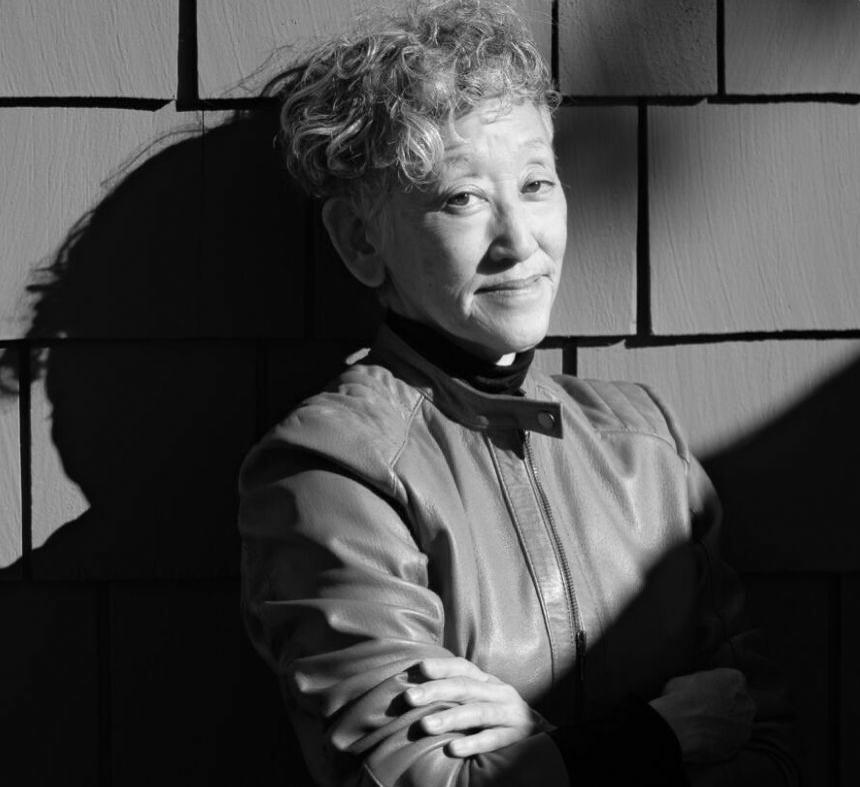
With several aspiring writers in the crowd, Yamashita concluded her
Friendship lessons from Korean barbecue
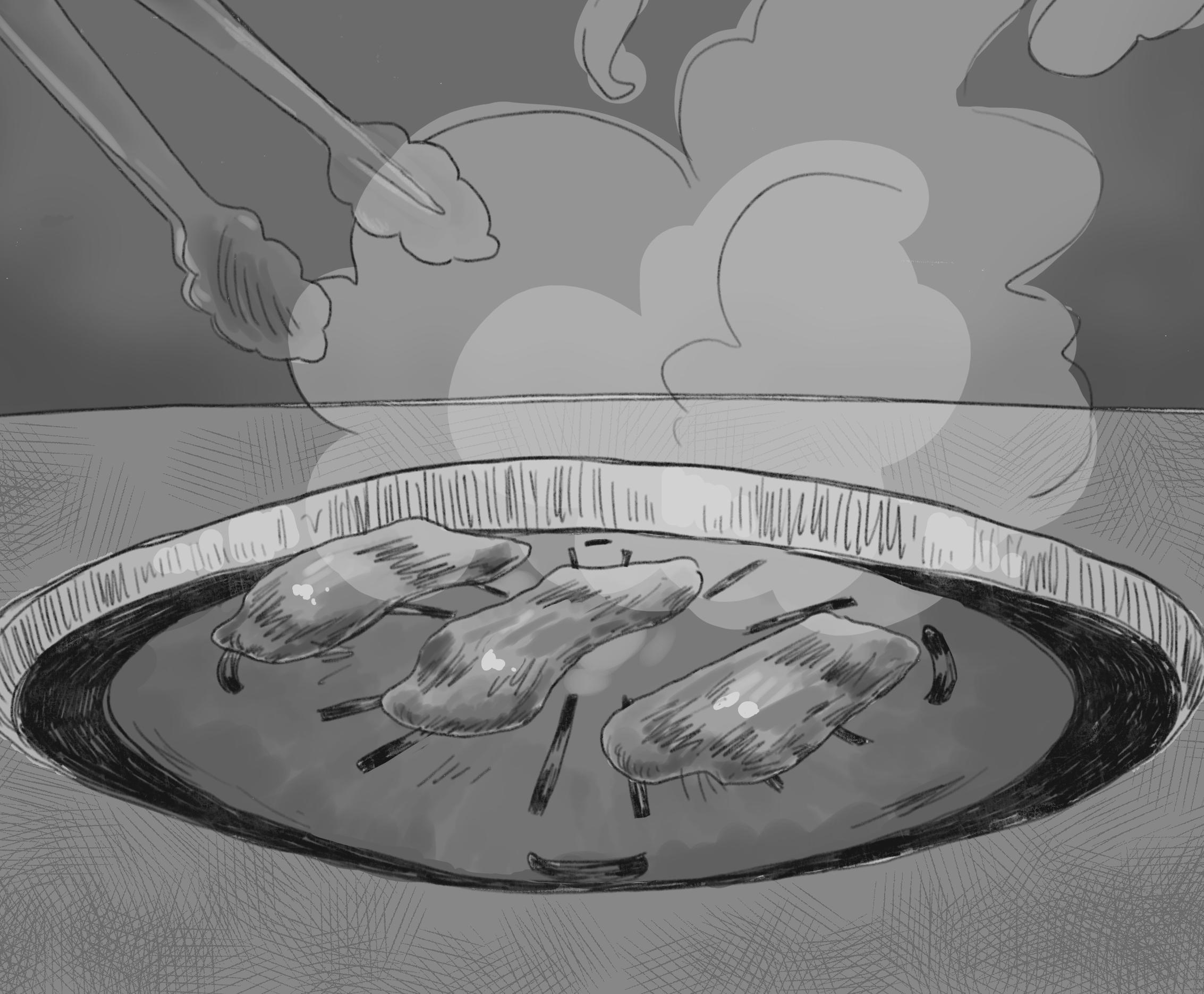
talk by sharing some writing tips.
“I just love to write. It’s the creative space I live in. But I’m very aware of everything I write,” Yamashita said. “There is an awareness within itself. But that’s the way I’m alive, so I’ll say that. If I get stuck, you know I just cook, clean the house [or] take a nap.”
“Joy” comes in all sorts of different forms. As for Yamashita, she finds joy in relearning the archives
of her family’s history and sharing her story with the world.
“You know you can hold each item and feel for the spark of joy, kick your foot back and point your finger up in the ‘joy’ position,” Yamashita said. “You reflect on the lives of every other curator and keeper of history along your incarceration road trip. You think that keeping this stuff and saving it might also be another way of transforming your life.”
‘Creative healing spaces’ at Pitzer’s Storyteller’s Festival
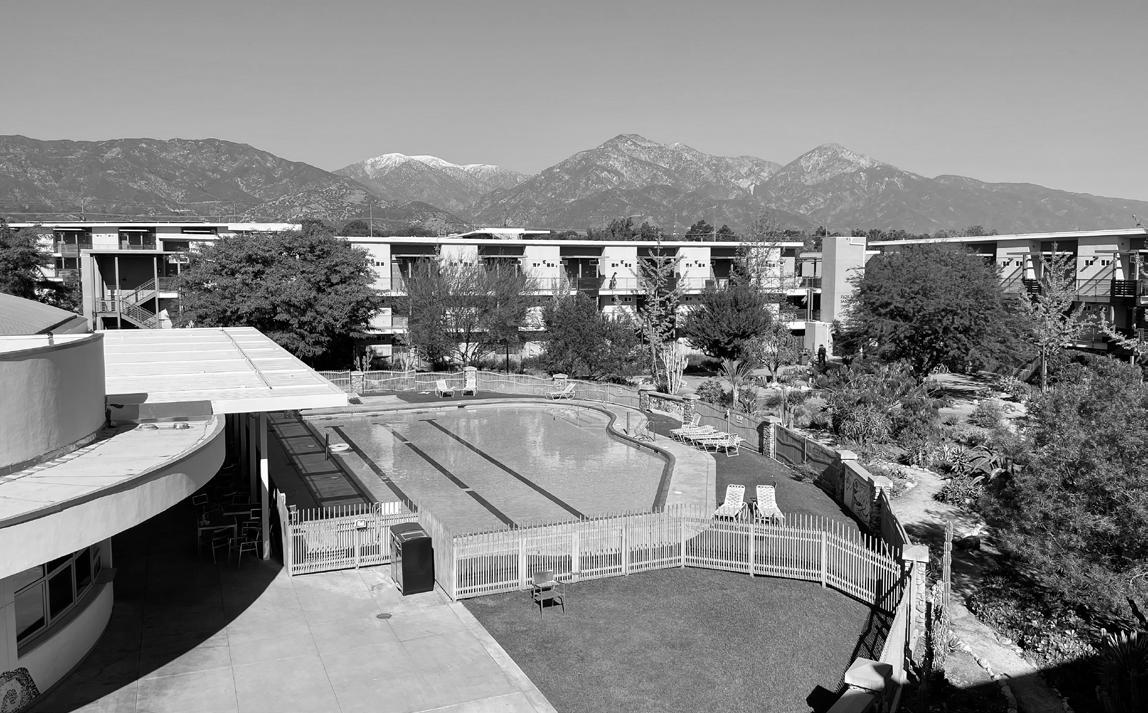
Music and activity boomed from Pitzer College’s McConnell Center Apron last week as art and food vendors invited students to experience communities beyond the classroom.
The second annual Storyteller’s Festival last Thursday, April 13 at Pitzer was a collaborative event to invite students to participate in communities on and off campus through spoken word, music, film screenings, art and food.
“The biggest ambition is to bring people here and expose students to what is going on outside of their campus,” Celia Malone PZ ’24, a fellow at the Writing Center and organizer of the event, said. “[We went] out into the community and [found] people who represent different aspects of storytelling through food, jewelry, art, conversation and writing.”
A host of groups worked in collaboration to provide students with the opportunity to engage in thoughtful conversation, including members of the Writing Center, Media Arts for Social Justice and Campus Life Committee, as well as groups not affiliated with the college such as the William James Association. This team effort allowed for many events to appear throughout the day for students to become active members of their communities and engage with purpose.
for all parties involved.
“When people engage the community around here, sometimes it’s really extractive, and so right here, it’s more collaborative, bringing people in,” Grell-Brisk said. Understanding the responsibility of organizing an event, those hosting made an effort to engage with as many stories as possible. By bringing students to sell their art and help organize the event, a variety of perspectives were presented.
One vendor, Zixi Yang PZ ’26, presented photographs, jewelry, posters and booklets at the festival for visitors to buy. She shared the way her professor reached out during a class to offer spots for selling art and the significance behind some of her art.
“This book is related to environmental issues with jewelry. I used those [jewels] to show human actions to nature,” Yang said.
Another way the community considered bringing people into the conversation was being aware of other groups’ work in the Pitzer community. The festival invited the Pitzer Black Student Union to engage in spoken word and highlighted the work that Claremont Student Worker Alliance (CSWA) is engaging in with Pitzer.
“Better understanding what labor networks look like in the areas around us is important for better understanding how we can support and uplift the people who work here in facilities,” Malone said.
When you step inside a Korean barbecue restaurant, you are swiftly greeted by the smell of sizzling chadol (beef brisket), samgyeopsal (fatty pork belly) and galbi (sweet marinated short rib). It’s a slightly overwhelming but wonderful scent — an unspoken welcome to the restaurant and the glorious, oftentimes allyou-can-eat, feast you’re about to have.
My friends and I got Korean barbecue after coming back from our church’s youth retreat, where we spent the entire weekend begging students not to pelt snowballs at each other and sleepily passing around gummy bears during our midnight staff debriefs. I remember entering the restaurant both exhausted from the weekend but also very excited to eat — I was ready to eat my body weight’s worth of meat that evening.
Our large group sat down at three tables and immediately started ordering, agreeing to start with beef brisket and getting some soybean soup, fluffy steamed eggs and salad for people to share. From the moment we sat down and ordered, I remember smiling and laughing; I was so grateful for this memorable weekend with these friends of mine. But once the food arrived, I remember smiling and laughing all the more. I realized that night that the act of eating Korean barbecue can teach you so much about friendship.
For one, no friendship is complete without fun and games. When the first platters of meat finished cooking and people started eating, I noticed my friend Charis at another table not grabbing any. “Why isn’t she eating?” I initially thought to myself. Then I heard another friend chuckle. “Charis lost a bet,” he revealed to the rest of us between laughs. “So she can’t eat any meat for 20 minutes.”
When my friend first started talking, I had just shoved a mas -
sive piece of kimchi-topped brisket in my mouth, double-wrapped in pink radish and rice paper. When he said that Charis couldn’t eat meat for 20 minutes, I choked from laughter, covering my mouth with my hand so that halfchewed beef chunks didn’t go flying everywhere. “There’s no way,” I said, grinning once I finally swallowed. I saw Charis cackling and vehemently protesting the rules of the bet, but sure enough, for those next 20 minutes, she merely fiddled around with some pickled cucumbers on her plate. And, as good friends do, we made sure to show her just how much we were enjoying the meat.
This dinner also made me appreciate my friends’ small acts of kindness. At Korean barbecue restaurants, I am a pickled radish fiend. I much prefer the radish slices over the gummy rice paper to wrap my meat in.
I like the way the tangy radish balances the saltiness of the meat and gives each bite the perfect crunch. I remember at one point during the dinner when the radish slices on my side of the table ran out. I shifted my gaze to where my friends were sitting, searching for radishes I could possibly steal before asking the waiter for more. Without even saying anything, my friend Timmy pushed a whole stack in my direction.
“They’re all yours,” he said, and my friend Gracie who was next to him nodded in approval. The little things in a friendship — even Timmy and Gracie recognizing and responding to my silly love of radishes — can go a long way in making people cared for.
The entire meal was chockfull of jokes like the one with Charis and sweet moments like the one with Timmy and Gracie. In addition to people giving you radishes, having the grill
meat
piece of samgyeopsal on your plate can make you feel especially touched. I realized that eating Korean barbecue with friends creates an experience where various aspects of friendship come into play. You laugh with one another, you share food and you give a friend a pile of radishes when you know they like them.
Now, I have a newfound appreciation for Korean barbecue restaurants that goes beyond being able to eat enough meat to keep me full for a week. From operating the grill to passing around the salad bowl, asking for banchan (side dish) refills and looking at the menu to order another round of meat, there is a role for everyone to play; indeed, eating Korean barbecue fosters a deep sense of collaboration among friends. The experience from start to finish creates a rhythm in which friendships can be strengthened in each step: you can crack jokes while ordering, chat while grilling and show people you care by sharing food with one another while eating. Moreover, there is a strong sense of camaraderie that develops when you all leave the restaurant to get boba — there is always room for boba after Korean barbecue — with your clothes carrying the distinct, smoky fragrance of pork belly.
Korean barbecue was the perfect end to a wild weekend with my friends, so perhaps it is the meal to get as the semester comes to a close. My advice to you? Put some meat on your friend’s plate. Give them some radishes. That’ll assuredly show them that you love them.
Emily Kim PO ’25 is from Irvine, California. Her ideal TSL column-writing set up is headphones in, listening to NewJeans or Lizzy McAlpine with a cappuccino (double shot) and a slice of banana bread in hand.
“This festival has always been about creating creative healing spaces where people can come together,” Ari Wood PZ ’21, an alum and organizer of the event, said. “[It’s about having that physical safe space for building community among the campuses but also with the surrounding communities.”
As the premier of the event was pushed to online workshops due to COVID-19 last year, the Storyteller’s Festival finally took place in person. Highlighting the significant gaps that were missing last year, this year’s festival focused on filling the spaces that a year apart created.
By hosting difficult conversations about oppression and marginalization, the storytelling focused on personal and communal experiences. This focus opened room for the festival to center all identities and share ethical ways of engaging with other communities.
“This [event] is about ... having more chances for interaction and creativity and holding conversations about social justice, about resistance to systems of oppression, as well, and what that looks like today in our world,” Wood said.
Marilyn Grell-Brisk is a professor of organizational studies at Pitzer and organizer of the event. She emphasized the importance of making the experience beneficial
Despite the collaboration and relentless work put into the event, the turnout was limited, with few people wandering in and out of events throughout the day.
“[The events] show how much more we need to show up for each other in community,” Mia Pizkett PZ ’26, an attendee of the event, said.
Professor Grell-Brisk agreed, noting that this is a common difficulty she faces when organizing such events.
“I’m always trying to bring folks in, and this is part of this trying to figure out how to bring the community here and to get students to interact,” she said.
As a festival designed for student outreach, it was apparent that student participation was lacking. The festival still curated a unique community and hope for the future of the Storyteller’s Festival.
This year’s Storyteller’s Festival was a collaboration of community outreach and representation, providing students with the opportunity to interact with communities outside the Claremont bubble, spoken word, music, art, food and film screenings created conversations of positive and thoughtful change.
“I hope,” Wood said, “that students are just inspired to continue having the conversations that are happening here today about how we are bringing about social justice and making it a reality in our day-to-day instead of just … an abstract topic of conversation.”
PAGE 8 APril 21, 2023 Arts & Culture
CARTER SOE
master — the friend who takes charge of grilling the
— personally putting a buttery
EMILY KIM
COUrTESY: SCriPPS COllEGE
JADA SHAVERS
MOMENTS TO SAVOr
lUCiA MArQUEZ • THE STUDENT liFE
As the premier of the event was pushed to online workshops due to COVID-19 last year, the Storyteller’s Festival finally took place in person.
CHASE WADE • THE STUDENT liFE
As the premiere of the event was pushed to online workshops due to COVID-19 last year, the Storyteller’s Festival finally took place in person.
How Leith Ross’ pen stands out amongst a generation of skilled lyricists
ABBIE BOBECK
Imagine this: You’re one year into the pandemic, have tried too many hobbies and are hoping for something inspiring to come along. Then you see a TikTok of a singer strumming their guitar and smoothly serenading you with gorgeous lyrics. This is what happened to me and so many others when Leith Ross started teasing their songs on the app in 2021. 24-year old queer Canadian indie singer Leith Ross is a force to be reckoned with.
Ross’ discography is an all-tooreal assortment of vulnerability, transparency and self-actualization. Their gift lies in their poetic songwriting that reflects common themes amongst Gen Z as well as their ability to detail relatable struggles through eloquent lyricism.
Ross’ first project was their 2020 EP “Motherwell,” which came to be from their senior project at Humber College in Toronto. With the backdrop of graduating college, “Motherwell”’s thematic context gains an extra layer of clarity. The EP is an introspective deep-dive into growing pains and the flood of childhood memories that arise as we grow up.
The first track of “Motherwell,” titled “Everyone I’ve Never Met,” explores the complexities of social anxiety, specifically in a time of extreme change and realization. Lyrics like “Highways make me fidget / There are way too many cars / And I’m sure I’d like the drivers / If we pulled aside to talk” provide a nuanced perspective of social anxiety. This issue has only grown more common since the pandemic, and since “Motherwell” was released in late 2020, it is a fair assumption to say the pandemic influenced the songwriting.
Ross sings about getting their food delivered and how they don’t talk to people anymore, noting the effect of human disconnect during the pandemic. The catchy outro flows with the strum of their guitar, “I miss everyone I’ve never met,” which touches on the idea that social anxiety can hinder their ability to connect with people, something
they hope to change. On “Prayer,” the fourth song on the EP, Ross questions their religion and belief in God. Explaining in the first verse they were raised to believe in God and the Bible, Ross reveals they can’t believe in a God that is not “as human as [them].” In a revelation, Ross confesses they need to believe in a higher power because without an explanation for all the brokenness in the world, life would be too lonely and scary. Track six, “Tommy,” is a nostalgia-filled ode to Ross’ grandfather. Following the theme of reflecting on childhood memories, the song explores their grandfather’s personality and how he influenced Ross as they grew up. The chorus
is written from the perspective of Ross’ grandmother as a message to her husband, showcasing Ross’ songwriting skills. Ross softly sings, “Oh Tommy I love that one / You used to sing it when you were young / Play it again, my love / For the kids to remember when they grow up.” This reflection on their grandmother’s notion that music would play a role in her grandchildren’s lives is a beautiful anecdote that adds a sweetness to the track. More recently, Ross announced their debut album “To Learn” which will be released on May 19. In anticipation, they have teased new music on their TikTok, as they did back in 2021. So far, Ross has officially released four of the songs on the album. Their recent releas-
es further solidify their destiny as Gen Z’s lyrical muse, despite a class of skilled wordsmiths.
“We’ll Never Have Sex” was Ross’ breakout song, with its Tik Tok tease reaching 1.2 million likes. This delicate love song is the first single on Ross’ upcoming album, setting in place themes of growing into ourselves and falling in and out of love. In the song, Ross explores having a partner that helps to melt your past hardships and trauma surrounding trust and commitment. The stripped-down chorus cuts deep, “Oh, you kissed me just to kiss me / Not to take me home.” Ross’s gentle tone and poetic imagery is enough to bring any listener to tears.
Ross’ single “(You) On My
Arm” is the gay love song of Gen Z’s dreams, not to mention the most upbeat track in their discography. The song is all about yearning for an intense crush and imagining perfect scenarios in your head. The innocent and charming lyrics like “I wanna buy you / Pretty little things / And never ever lie to you,” make this the perfect tune to play at a picnic or when frolicking through a flowery field. Ross is not afraid to address taboo topics and explore painful experiences through vulnerable lyrics. Their latest single “Guts” explores the aftermath of sexual assault and processing the complex emotions that come with healing from a traumatic experience. In the song, Ross avoids their abuser in public and explains the different lines they hear from friends and friends of their abuser, and they sing about how these opinions influence their healing process. In a stunning revelation, Ross sings about wishing they had the guts to punch their abuser in the stomach. However, the most jarring lyrics come in at the post-chorus and bridge where Ross dares to ask the question: “But do their mothers know?” In their reflections on traumatic experiences, Ross brings humanity back into question, even admitting they know it’s not the mothers’ fault and saying, “but I do think that she’d cry if I called.”
Leith Ross is a rising star amongst a generation of candid lyricists. They are able to tackle difficult topics and provide nuanced perspectives on typical love songs in a way few artists are doing to this day. Their gut wrenching lyrics bring a balance of discomfort and comfort for Gen Z listeners hoping to find someone who understands their deepest insecurities and complex emotions. Ross is just getting started with their songwriting, and as they tease more and more songs on their TikTok, fans such as myself are anticipating more great music in the future.
Abbie Bobeck SC ’26 is from Washington, D.C. She enjoys tanning at the beach, sugar cookies from Malott and a London Fog from the Motley.
Gender, sex and the carceral system: Panelists describe roots of their prison-abolition activism
On April 16, in the Rose Hills Theatre at Pomona College, the 5C Prison Abolition Collective held the final event of its semester-long speakers series. The discussion, titled “Femme Futures: Beyond Carceral Institutions,” brought together three panelists, Jessica Gonzalez Rodriguez, edxi betts and Victoria Perez, who spoke about their direct experiences with the prison system and their resulting prison-abolition activism.
Michaé de La Cuadra, a Los Angeles-based policy maker and trans activist, served as the event’s moderator. La Cuadra’s work has included lobbying for and passing AB2218, the Transgender Wellness and Equity Fund, a state law that funds holistic health services for trans, intersex and gender non-conforming people.
A student-run group, the 5C Prison Abolition Collective works to engage, educate and activate the community in order to create alternatives to imprisonment. This spring, the organization has brought multiple speakers to campus to educate students and faculty about the damaging effects of the prison industrial complex.
“I hope that from the series as a whole, people took away that abolition is at the intersection of several movements,” club member Blessing Roland-Magaji SC ’24 said. “The hope is that people go beyond thinking about abolition as just about policing and prisons but to think about how abolition is necessary for liberation when thinking about, for example, reproductive justice.”
Panelists explored the impact of the intersection of carceral systems, gender and sexuality, with many speakers describing how being trans leads to greater exposure to imprisonment and abuse within the system.
Perez, who grew up in the San Gabriel Valley and is just 20 years old, was formally incarcerated for four years. She explained how her incarceration experience was made worse as a trans woman.
“My activism started in the juvenile system as the only transgender
woman in the juvenile prison up north,” Perez said. “I wasn’t taken seriously, you know, like, ‘you’re young, it’s just a phase,’” she said. “I was more prone to sexual assaults or sexual harassment. When I started, we weren’t separated … I was in the men’s institution.”
Similarly, betts, who identifies as an autistic Afro-Indigenous transfeminine and is a multi-disciplinary artist, organizer and 2020 Mellon Foundation Artist-In-Residence for the Feminist and Gender Studies Program at Colorado College, was also incarcerated. She explained that her experience of being unhoused forced her into desperate situations where she felt the only way out was to steal and engage in sex work, which led to her arrest.
“I’ve been to jail … being on my last legs, being houseless [and] not having any resources,” betts said.
“Having to go to male prison looking like this, looking like me, do you know what that was like? That was crazy. The

dudes that I was in prison with were like, ‘what is this? There’s a girl in here, y’all.’”
Rodriguez is a community organizer and digital strategist whose work was described by 5C Abolition as being “at the intersection of trans, queer and migrant justice to see a world without prisons, borders and binaries.” Rodriguez described the hardships many trans and queer immigrants face when seeking asylum, partly because they often face family rejection because of their identity.

“One of the challenges of getting released from Immigration Detention Center is that you can be put in full flight risk, which means that you have to have family ties in the
United States. We know that for queer and trans people that those ties get severed, especially because of transphobia in the family,” they said.
Many of the speakers addressed the nuance of abolition work: how even as they expand resources and rights within prisons, jails and detention centers, the end goal is to eliminate the prison industrial complex altogether. For example, betts clarified that while being forcibly housed with people of a different gender is traumatizing, they don’t think simply reforming the existing system is sufficient.
“I don’t think the solution to the uptick of trans people going to prison is more trans-inclusive prisons,” she said.
Instead, betts and the other panelists advocate for what they called “transformative justice,” which puts conflict resolution in the hands of individual communities rather than in the hands of the state, where it has historically been mismanaged.
“A lot of the time, many of the people
who are incarcerated, especially those that are part of our community, end up incarcerated for reasons that are related to survival or because the systems that exist outside of carceral institutions haven’t been set up to support us,” explained La Cuadra.
5C students attending the event expressed eagerness to learn from the speakers.
For audience member Nithya Kumar PZ ’24, a moment that stood out was when betts asked the audience if they believed human trafficking is wrong.
“Obviously everyone raised their hands,” Kumar said. “And then the speaker said, ‘well, think of the prison system as human trafficking but legalized’ — I think that’s how everyone should think about it.”
Others were eager to find out how they could further their work and ideas. Another audience member asked panelists what the role of student organizations or academic institutions can be in abolition work. Panelists encouraged students to continue having conversations about prison reform, learning from each other and exposing students to important work that can lead to positive change.
“We don’t want to be like Florida where they’re like, ‘let’s not talk about slavery, you can’t say gay,’” Perez said.
Additionally, panelists spoke about the struggles of balancing activism and school. However, they encouraged students not to give up, pointing to historical student involvement with groups such as the Black Panther Party or support for the Chicano movement at UCLA.
“Bring people who are directly impacted who you can learn from. Pay community members.
There’s a lot of money in the university, in this institution, that you can literally grab and reallocate,” Rodriguez said, suggesting opportunities for future dialogue. Students interested in learning more about the Prison Abolition Collective can contact 5cprisonabolition@ gmail.com.
APril 21, 2023 PAGE 9 Arts & Culture
JO KEYSER
ABBiE ON AUX
COUrTESY: MiCHAÉ DE lA CUADrA
Michaé
lUCiA MArQUEZ • THE STUDENT liFE
de La Cuadra, a Los Angeles-based policy maker and trans activist, served as the event’s moderator.
CMC, where are your ‘Responsible Leaders?’
The ASCMC Resolution demonstrated an ignorance that only my privileged peers could possess, illustrating something far beyond simple misunderstandings — Claremont McKenna College students don’t care to know each other.
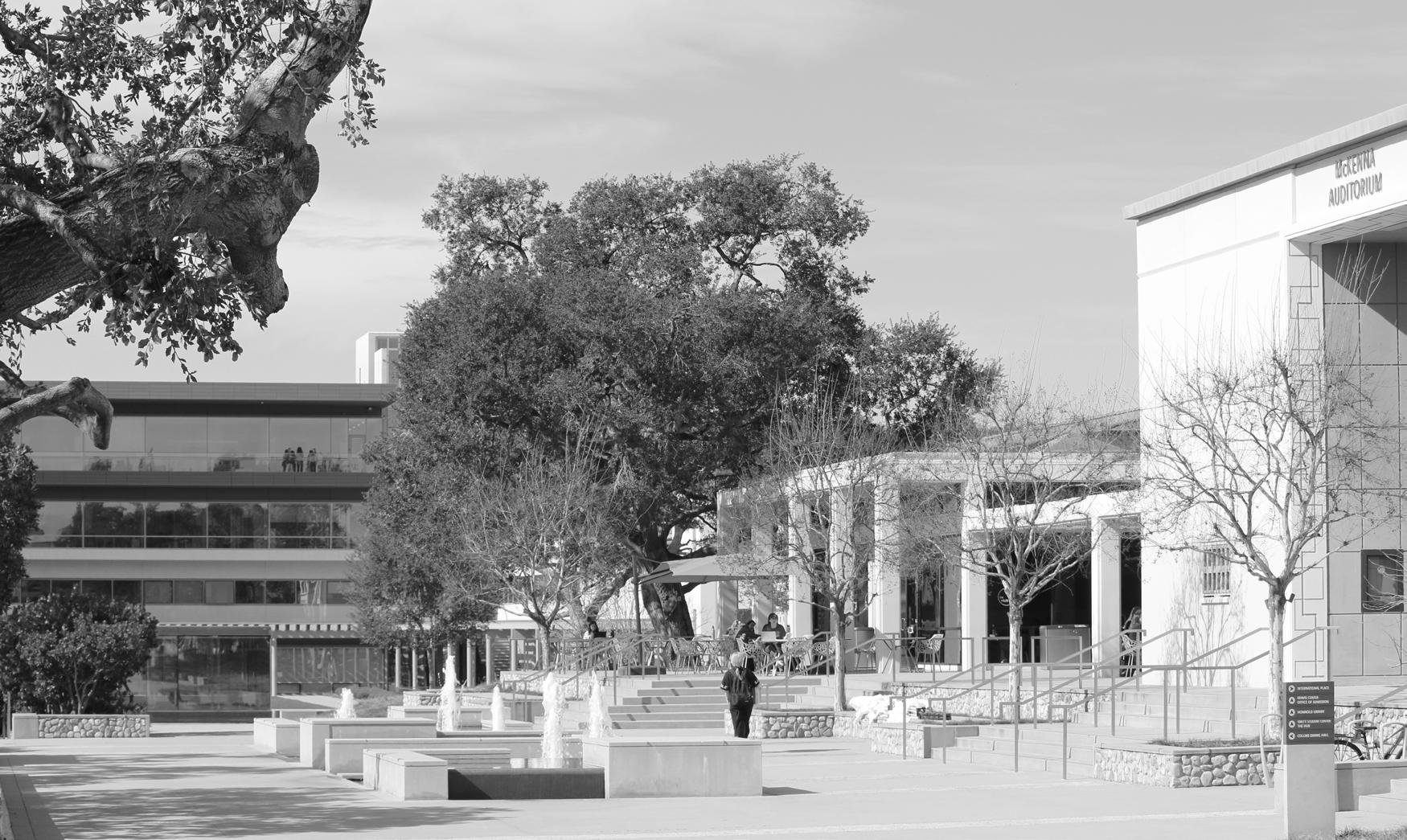
As a campus, we have oversold ourselves. We pride ourselves on the fact that we are a “small, tightknit community.” Over and over again, I hear many of my peers interpret CMC as an island of equality with the impossibility of exclusion. This has led to an absence — a silence — about the difficulties of marginalized students in our community.
By now, I think most of CMC has heard of the well-attended Senate on Feb. 6, where the Special Committee members failed to define inclusivity in terms of addressing real concerns of marginalized students. That’s where most of the campus knows my face and name, at least. Admittedly, it is hard to articulate my observations, experiences and interactions over the course of the previous months, but it is important that students understand what I recognized and why I took actions when others did not. It’s not the three hours on a Saturday night that frustrates me, it’s every hour of every other day. We’re exhausted.
Just a week before that Senate meeting, I attended a much smaller Senate. After reading the resolution and hearing sound bites from other students, I was furious that such a select group of students co-opted inclusivity and shamelessly attacked, perhaps, the last thing that most students are irritated with CMC about: its alcohol policies.
As I waited for the Senate to begin, about 70 of my peers filled the room. Spoiler alert: they were over-
For Camille Forte CM ‘23, February’s ASCMC r esolution hearings have brought the entire ethos of CMC into question.
public apology could ever change my opinion of them, but they will never do that because no coaches, administration or teammates will ever demand it. Instead of furthering efforts to prevent such gross misunderstandings of each other, the Dean of Students (DOS) office placated the Special Committee members with the Social Life Working Group. Of all students, they were invited to meet with the Board of Trustees this past Thursday. The Working Group is not representative of the student body. It is a figurehead for ASCMC politics and the Special Committee. DOS should have let “kegs for inclusion” die on its hill in Senate. Why do we reward ignorance here when we admonish it in the world around us?
These events have brought the entire ethos of CMC into question. We boast responsible leadership, learning across differences and a tight-knit community, yet we have never been more socially divided.
white, CMS (Claremont-Mudd-Scripps) athletes and North Quad residents. I knew their names and faces, and I counted their bodies. I was shocked by the silence that ensued when the Chair of the Special Committee and another Senator continuously asked me for answers and solutions to their problem. Everyone looked pretty comfortable in that room, hiding in the rank and file of their teammates and suitemates. Are any of us surprised that these students, those with the most insular interactions on campus, support such an outrageous statement that white students don’t feel included at their own parties? Their vote of 43-0 carried to adjourn. Of course, it is often those with the least to lose who
whelmingly
stay the quietest, isn’t it?
After the Feb. 6 Senate, what was left of the Special Committee wanted to meet with me. I had one message for them: “You messed up! You have no idea what you’re talking about, and you need to make it right.” At least two of them agreed with me, and they admitted a dangerous truth. They had no idea their peers of color were so frustrated with their experience here. Three years. That’s how long the Special Committee members have been here. I couldn’t release the tension from my face. But what does race have to do with it? Imagine a room with 70 white students (again, with faces we recognize) declaring not that they know what inclusion is at CMC but that they know better.
Are we surprised that I, and my other peers of color, saw this as a problem? We know what comfort looks like because we experience discomfort in every part of campus. Those able to disengage do so from a privilege only proximate to whiteness. I encourage you to sink in your seat with discomfort like so many did at Senate.
Once again, I return to the failure of CMS Athletics. Members of the least diverse team (CMS women’s lacrosse) and members of the most isolated team (CMS men’s football) had the greatest turnout for the Resolution, although none of their members participated in substantial dialogue. Men’s baseball, women’s soccer and more individuals completed the silent bystanders. Nothing less than a
We as students need to acknowledge who has worked to embody the full scope of our community ideals. It may not be your students in selective clubs, athletics or even your resident assistants. These students discuss difficult topics in the CARE Center. These students sustain themselves and their families by working more than four on campus jobs. These students actively work year-round with administration to improve our institution.
We need to acknowledge the real work –– not the politics of ASCMC –– that students of the least means constantly return to our community. We need them at the table.
Camille Forte CM ’23 is excited to finish her history thesis this weekend, graduate in a couple weeks and return to Chicago in a month, leaving her senior year at CMC behind her.
An alternate avenue to gratitude
Gratitude is wildly undervalued — but not in its most common form.
We can (and often do) express our thankfulness for meaningful aspects of our lives, like our loved ones or life-changing opportunities. The seemingly negative life events, however, are just as important. For me, this decision to choose gratitude, to choose to find appreciation in life’s tragedies, is deeply personal. Today, I feel ready to share that journey with you.
My propensity for gratitude is not something I have always had. However, it was a negative experience that gave me my start. In October of 2021, just two months into my first year at Pomona College, I made the difficult decision to take a medical leave of absence.
I was bitter and isolated, living at home and working full-time once I was physically able to, while my friends were together and continuing their education.
But when I had submitted my documents to officially return and restart my first year this past fall, I came to the realization that taking a leave of absence was one of the best decisions I have ever made. I would have hated to admit it at the time, but the only way for me to improve my physical health was to take myself out of an environment where I wouldn’t get the chance to recover, which meant going home.
Around that time, I also figured out what I really wanted to study, so having a fresh start on my academics gave me the opportunity to explore my newfound interests. Even though taking that leave was one of the lowest points of my life,
I am forever grateful for it. I may still be chronically ill, but learning from my previous experience gave me the skills and confidence to come back.
Yes, gratitude can even stem from less-than-ideal experiences. For example, in these situations, I am not only grateful for the experience, but also that it gives me a way to learn more about myself (and my actions) and use it to improve my life — and from there, the lives of those around me.
The situations I’m referring to are those which are rarely advertised as something to be grateful for. For example: having a fault or mistake pointed out to you. I can say with confidence that not many people want to acknowledge their flaws. So, why am I telling you to be grateful for them? This situation shows that the person telling me is someone who cares enough to want me to know, but that I am always learning and changing. Besides, if we always stayed the same, what fun would that be? How would we ever experience personal growth?
However contradictory the idea of gratitude for negativity may sound, I have learned that I am able to gain much insight and strength from seeing how I navigate stressful and upsetting situations. More often than not, we neglect to see that gratitude is not just about the past, but the future.
Research has shown that gratitude can improve our physical and mental well-being. Actively practicing the feeling of thankfulness –– especially in unlikely instances –– can help us counteract our inherent tendencies to
try and solve every problem we come across. Because not only is that strategy miserable, it’s also a difficult task. But taking a little time each day to show appreciation for both those around us and for ourselves is easy. So, why not give it a shot?
Sure, practicing gratitude for uncontestedly positive things might come easier. These are the forms of gratitude practice we are more familiar with. For example, recently, a friend brought me a bottle of Gatorade when I was sick. So, when we got lunch the next day, I arrived with a hand-written thank-you card
in hand. Something like a quick stop by my dorm to drop off a drink may seem insignificant, but showing my immense appreciation made the experience more meaningful for both of us.
As for finding positivity within negativity, avenues are less traditional but equally important. On my end, I started a journal this year. I had previously been adamant about never wanting to write in a journal –– I felt that having a physical manifestation of my negative thoughts was certainly a bad idea. However, writing down the stressful or upsetting things I feel each day is
a relief. When I look back at each entry, I can see how much I have been challenged, how much I have overcome and how much I have grown. That sounds like something to be thankful for. Maybe I’ve become someone who sees more silver linings, but I doubt that it’s something that needs to change. Being thankful for the negative as well as the positive translates into a broader thankfulness for life.
Dania Anabtawi PO ’26 is from New Haven, Connecticut. She enjoys walking too quickly and going to bed by 9 p.m.
Jasper’s Crossword: Untitled Word Puzzle


paper)
65. Pre-owned DOWN
1. Stuff, food-wise
2. Point out a red flag
3. Tap that!
4. Wii Sports Resort competitor
5. Baseball great Lou
6. Excited altar response
7. “Your majesty”
8. Starts to need a massage
9. Bell tower’s emission
10. “Horrible” Viking of comics
11. Historic mission/car rental service 12. Judi Dench and Mary Berry, for two 13. Loses one’s fur coat?
18. Aquatic shade of blue
23. What elbows divide
25. Spider’s spot
39. Dolt, in Yiddish

41. Reason for make-up work
44. Prickled
45. “Somebody ___” (Queen song)
46. They warm up a crowd
47. Commuter rail stops, for short
48. Chemically unreactive
49. Discovery’ astronaut Ellen
50. Poke some piano keys
54. Drag accessories
55. Game-entering move
56. Signed off on 59. “slide into my DMs...”
LAST WEEK’S ANSWERS
53. Egyptian queen, for short
King” and Oscar in “Arrested Development”
54. Tasty steamed bun
57. Adjusted on the wall
58. *Sound you might hear from 17, 26 or 43-across
60. Denver footballer 61. Apple consumer, initially? 62. Game-ending move
Battened, as a tent
___ Spiegel (German news -
26. It precedes “E-F-U” in a hit song
27. Arabic name meaning “light”
28. Elapse
29. “___ to Joy”
32. “Well, certainly!”
33. Campfire fuel
34. “Just Dance” artist
35. Soccer star Morgan
37. Messes with nature, perhaps
38. Place for a stud
PAGE 10 APril 21, 2023 Opini O ns
DANIA ANABTAWI
FORTE ANDrEA ZHANG• THE STUDENT liFE WENDY ZHANG • THE STUDENT liFE
CAMILLE
JASPEr DAV DOFF • THE STUDENT liFE ACROSS 1. Do the butterfly 5. General summary 9. Alpha males 14. Group with a May heritage mo. 15. Falco on “The Sopranos” 16. R&B singer Hathaway 17. *It’s used at many a level crossing 19. Best effort 20. One might be burnt or split 21. March/April star sign 22. Christened 23. Enthusiastic 24. “That’s disgusting!” 26. *Potential hazard with a long neck 30. It thrice follows “Gotta get that” 31. Add later, as dialogue 32. Merediz of “In The Heights” 36. They hold kernels 37. Easter chick 39. Bunch of fish 40. Like British humour, some say 41. “Vamos ___ Playa” 42. Cozy Danish feeling 43. *Lisa Simpson’s instrument 47. Test for a lump 51. Literary theme 52. Scar in “The Lion
63.
64.
Sagehens in the majors: Arizona Diamondbacks coach
Drew Hedman PO ’09 is bringing DIII to the MLB
BEN LAUREN
In November, as part of an article on the long-standing relationship between PomonaPitzer (P-P) baseball and the Boston Red Sox, TSL interviewed former Sagehen first-baseman and current assistant hitting coach and head of minor league hitting for the Arizona Diamondbacks Drew Hedman PO ’09. Hedman, who was drafted by the Red Sox and played four years in their system, spoke on his time with P-P, experience moving from Division III to the minors and his approach to coaching today.
This conversation has been lightly condensed and edited for clarity.
TSL: What was it like to be the trendsetter to start this wave of players from P-P getting drafted by Boston?
DH: I ended up waiting until the last round. I think I was a third from the last pick. I remember when the Red Sox selected me, it was a no-brainer. I [had] accepted a consulting job and happily called them the day after I was drafted and told them I was [going to] go play instead of pursuing that opportunity. At the end of the day, [I am] fortunate that that was a reality for me. In many ways, even after I finished playing, it paved an early path for the types of opportunities I pursued after — from coaching at the collegiate level and now being back in professional baseball as a coach, and I certainly think it opened some doors for me.
TSL: When James Kang PZ ’10 was interviewed, he talked about being a DIII player making the transition into the minors. He was saying that there’s no bias against people coming from different levels. Would you agree with that?
DH: I think in that setting, if you perform, you’re going to get opportunities … you’re [going to] move up the ladder and [it could] manifest itself in getting an opportunity at the major league level. A couple years ago with the Diamondbacks, [I] coached Tim Locastro, who was a DIII player at Ithaca College.
He performed and he’s been getting some opportunities in the big leagues. He was with the Yankees just last year.
TSL: Do you think that you could tell me a little bit about your time in the Red Sox organization, how each level was different or just any general thoughts you have?
DH: My first year was the summer of 2009, which was the year I was drafted. And I think back to our biggest games — we probably had 100 people in the stands for a P-P versus CMS (Claremont-Mudd-Scripps)
matchup. And, you know, most of them are a couple of roommates and parents and siblings. One of my first games playing for the Lowell Spinners [the Red Sox class A short season affiliate at the time], there were 6,500 fans in the stands. And 6,500 is still a far cry from what you’re gonna see at Fenway Park, but it was definitely different than having 100 People at Alumni Field on a Saturday morning. I remember just that kind of energy and experience … They won a World Series just a couple years before I was drafted and so [there was] a lot of buzz and support throughout the organization. I played my first year in Lowell, Massachusetts and my next year trumped up to High-A. And I split time, or served as basically the backup first baseman, to a guy named Anthony Rizzo … I remember thinking, ‘Man, this 20-year-old player [is] … pretty good.’ And then, before you know it, he ended up winning a World Series with the Cubs and just had a great year with the Yankees … I played, whether it’s from training or on different teams, with Mookie Betts, Anthony Rizzo, Xander Bogaerts, Christian Vazquez and Ryan Pressley, who just closed out the World Series for the Astros … So a pretty impressive list of players there and just getting to compete against athletes at that level and, you know, seeing how talented they were and being on the field with them was a pretty special experience as well.
TSL: What do you think are some of the main things you try to focus on as a hitting coach?
DH: I think the biggest thing is really individualizing instruction … and planning … for each athlete. Obviously, everyone’s very talented and everyone’s different, and I think the more that we can tap into that individuality for each player [the better] … That includes everything from biomechanically how they work, technically how their swing works, fundamentally what areas of the game they need to improve upon, whether it’s swing decisions or training more bat speed.
TSL: What do you think that as a player you’ve taken away from your minor league or collegiate career to put into coaching?
DH: A lot of different parts. And I think one that is important to remember is knowing it can be a hard game … And I think that can be true for people as they make adjustments, whether it’s going from high school to college, college to the minor leagues or minor league to the major leagues. Understanding what everyone’s going through emotionally and physically as they’re trying to acclimate is going to help them on their journey … I was able to play for four years and at times when you’re in it … four years can go by pretty quickly. And it’s also just trying to enjoy that moment, enjoy the practices, the trips, the games, seasons and all of those experiences as much as you can.

Pomona Mountain Project brings mental health outdoors to high schoolers in the Inland Empire
BEN LAUREN & DANIA ANABTAWI
Hiking through the various terrains of the Inland Empire and developing unique nature-based artistic workshops, Sean Perez PO ’23 and the Pomona Mountain Project (PMP) are dedicated to giving nearby high school students an unorthodox approach to mental health care.
Working with students from Ganesha High School in the city of Pomona, PMP runs a wide range of activities from nature walks to gardening sessions to, most recently, a class on Do-It-Yourself (DIY) journal-making. This most recent development is aimed at teaching students that journaling and imperfection go hand in hand.
Perez said he believes experiencing the outdoors can be so beneficial to mental health.
“Going outside and taking hikes or going on walks isn’t something that most people traditionally think of when they think of mental health,” Perez said. “The fact that there’s so many different forms of being outdoors here in Southern California emphasizes the fact there’s so many different ways to work on mental health.”
Since its founding by Shawn Trimble PO ’21 and Nicole Arce PO ’21 in 2019, PMP has faced a number of difficulties navigating the pandemic and the return to campus in 2021. Nevertheless, Perez, who took over as PMP’s head coordinator in spring of 2021, has championed its resurgence and navigated the process of setting up the program with Ganesha.
Perez explained that many of these students are from lowincome backgrounds, speak English as a second language, are from immigrant families or are immigrants themselves. Accessible and affordable mental health resources are difficult to come by due to a lack of funding and resources within the school; it is not, however, due to a lack of heart from its teachers.
Perez made this blatantly clear when crediting the group’s point person at Ganesha, Danielle Rasshan, in helping them achieve such success.
“[Rasshan] is the sweetest person I’ve ever met in my life,” Perez said. “She’s been incredibly supportive to the program … She [has been] incredibly supportive and
encouraging … and she’s just been this ray of sunshine with the kids and with us.”
In working with teenagers, college students have a unique perspective standing somewhere between adolescence and full adulthood. Selena López PO ’22 said she believes this sets up PMP for success in the field.
“These high schools often don’t have the resources or capacity to engage with students in such a way that encourages them to go outside and to take hikes and to talk about their mental health,” López said.
“If PMP can provide that avenue … and do so with connecting college students who are passionate about this kind of stuff, I think it can really make a strong difference.”
López is the postbaccalaureate fellow of Educational Outreach at the Draper Center for Community Partnerships, an organization at Pomona College that aims to support and engage with local communities. PMP is just one of many programs offered through Draper.
Speaking on Draper’s role within the greater Inland Empire, López explained that the 5Cs can often create a bubble for students,
preventing them from seeing socio-economic issues present just outside of Claremont.
“We are given this immense privilege of going to a school like Pomona College without really understanding the context surrounding [it] … where … there aren’t as many resources to support these underserved communities,” López said. “I think that by being involved with the Draper Center, you really get to give back in a meaningful way that is grounding for a lot of our education that we receive here.”
The center currently offers 15 programs whose goals range from supporting mental health in marginalized communities, such as PMP, to identity-based mentorship programs that provide meaningful mentor-mentee relationships, to programs with a focus on teaching students skills and knowledge they might not otherwise have access to in their communities.
Programs are designed by student coordinators themselves and then given resources by Draper to help them achieve what they are looking to accomplish.
While each program brings something unique to the table,
Draper not only provides them with individual support, but also helps form a community between them.
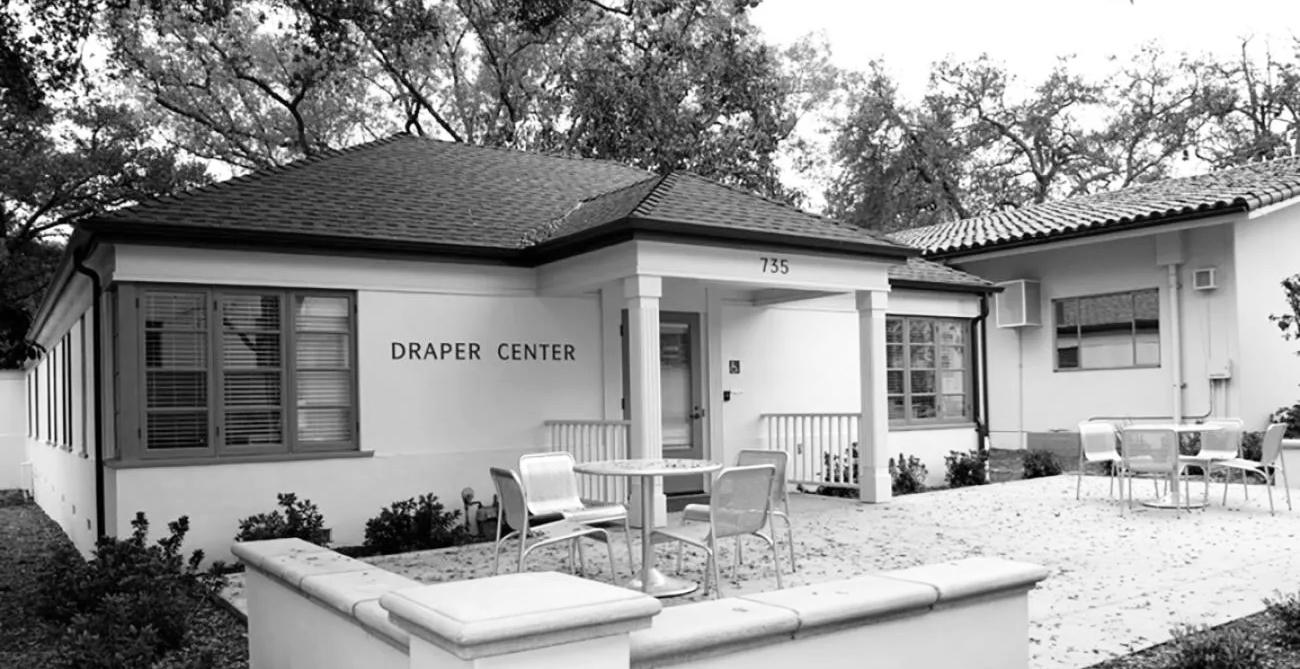
Assistant Director of the Draper Center Rita Shaw, who manages and works closely with each program’s student coordinator, highlighted the power that comes from building connections between her students.
“There’s a beauty that comes with bringing everybody together,” Shaw said. “When like minds get together … it’s just a high all by itself … and that synergy happens, and we create incredible things.”
Draper additionally supports its volunteers and coordinators through events including a Community Engagement Awards night on May 2, open to the general public.
Unfortunately for PMP, with Perez graduating and no one currently in line to take his place, the program will be put on hiatus starting next fall. Because of the difficulties the club has faced in finding a school to work with and a solid volunteer base, without someone to take on these responsibilities, this may be its last year. Still, Perez felt optimistic about mental health within the
Draper Center going forward.
“There’s plenty of other programs in the Draper center that have similar goals [as PMP],” Perez said. “Rooftop Garden is a great one that does a lot of outdoor wellness … and there’s also a bunch of different programs that work with Ganesha as well. I encourage anyone who’s interested in volunteering … to go to the Draper Center and ask about the different programs and how they can get involved with the community.”
Ultimately, volunteering can be difficult work for college students without much formal training. Regardless, Shaw and the Draper Center believe that people like Perez are making a difference in the lives of the people they are looking to help, even if it is not immediately evident.
“One person plants the seed [of mental health], another waters it [and] another reaps from the harvest,” Shaw said. “You may not even remember their name, but someone planted a seed in you a long time ago, and it came back at the appropriate time. And so now, it’s not the first time you heard it, and the second time you heard it, it had more value to it. That’s community programming right there. You do it because you have a heart to do it.”

April 21, 2023 pAGE 11 Sport S
Drew Hedman pO ’09 hits during his senior season as a Sagehen.
COUrTESY: SAGEHEN ATHlETiCS
COUrTESY: pOMONA COllEGE
GRACE SAUERS, Production Editor EMMA CONSTABLE, Production Editor KYLIE MIES, A&C Designer PAUL YAN, Opinions Designer SELINA LU, Sports Designer JULIA VICTOR, Copy Chief DANIA ANABTAWI, Copy Chief CHASE WADE, Photo Editor WENDY ZHANG, Photo Editor BELLA PETTENGILL, Creative Director SASHA MATTHEWS, Graphics Editor SARA CAWLEY, News Editor MAXINE DAVEY, News Editor JAKE CHANG, News Associate INDIA CLAUDY, Arts & Culture Editor TANIA AZHANG, Arts & Culture Editor EMMA NEWMAN, Arts & Culture Associate ABBY LOISELLE, Opinions Editor ELENA TOWNSEND-LERDO Opinions Editor BEN LAUREN, Sports Editor ANSLEY WASHBURN, Sports Editor JENNA MCMURTRY, Special Projects Editor ANURADHA KRISHNAN, Special Projects Editor ANNIKA WHITE, DEI Editor MANAN MENDIRATTA, DEI Editor HALEY WEBB, Business Manager CLARE A’HEARN, Social Media Manager YAHJAIRI CASTILLON, Social Media Manager KANA JACKSON, Multimedia Editor SEOHYEON LEE, Web Developer SIENA SWIFT News Editorial Assistant MARIANA DURAN News Editorial Assistant THE STUDENT LIFE HANNAH WEAVER, Editor-in-Chief AVERI SULLIVAN, Managing Editor GERRIT PUNT, Managing Editor TSL’s Editorial Board consists of the editor-in-chief and two managing editors. Aside from the editorial, the views expressed in the opinions section do not necessarily reflect the views of The Student Life. Single copies of TSL are free and may be obtained at news stands around campus. Multiple copies may be purchased for $0.47 per copy with prior approval by contacting editor@tsl.news. Newspaper theft is a crime; perpetrators may be subject to disciplinary action as well as civil and/or criminal prosecution. Editorial Board Senior Staff
The Draper Center for Community partnerships at pomona College.
In the season’s final sprint, CMS track and field is looking to run it back
SENA SELBY
Claremont-Mudd-Scripps (CMS) men’s and women’s track and field quickly raced to claim the conference’s top spot in 2022. As two of the conference’s most illustrious programs, the Stags and Athenas are looking to run it back this year, and after several strong performances already this season, they may be on their way.
CMS men’s track and field has been the most dominant team of the past few decades, winning 26 conference titles since 1992. This year is no different. According to the latest USTFCCCA National Ratings Index, the men’s team is currently ranked No. 2 overall. This comes after a dominant showing at the Multi-Dual at Occidental on April 1, where the Stags swept Whittier, La Verne and Caltech, winning each matchup by over 100 points.
Stags captain Christian Campbell CM ’23 has already secured a record-setting season, breaking the program’s former 200-meter record with a time of 20.92 seconds at the Multi-Dual and its 100-meter record, which stood for 35 years, with a time of 10.47 seconds at the Pomona-Pitzer All-Comers meet on Feb. 18.
Campbell currently sits at No. 2 nationally in the 200-meter, No. 6 in the 100-meter and is also part of the top-ranked 4x100 relay with Quincey Williams CM ’24, Nick Teresi CM ’24 and Joshua Martinez HM ’25. He credits his successes to his improved commitment to the team.
“I think the biggest thing that’s helped me improve is my passion for the sport,” Campbell said. “Last season, I was putting in the same amount of work, but I wasn’t as into it as I am now. This year I am really
focused, and I have just been really consistent with my dedication.”
CMS women’s track and field has also been dominant this season, sweeping all three of their SCIAC Multi-Duals. Their perfect record against SCIAC opponents has secured them a ranking of No. 3 in the West region, according to the latest USTFCCCA Regional Rating Index. Although Redlands sits at one spot above CMS in the region, the Athenas are the favorite to win SCIACs, which would be their eighth in nine years of competition, and have also set themselves up well for success at the NCAA DIII National Championships.
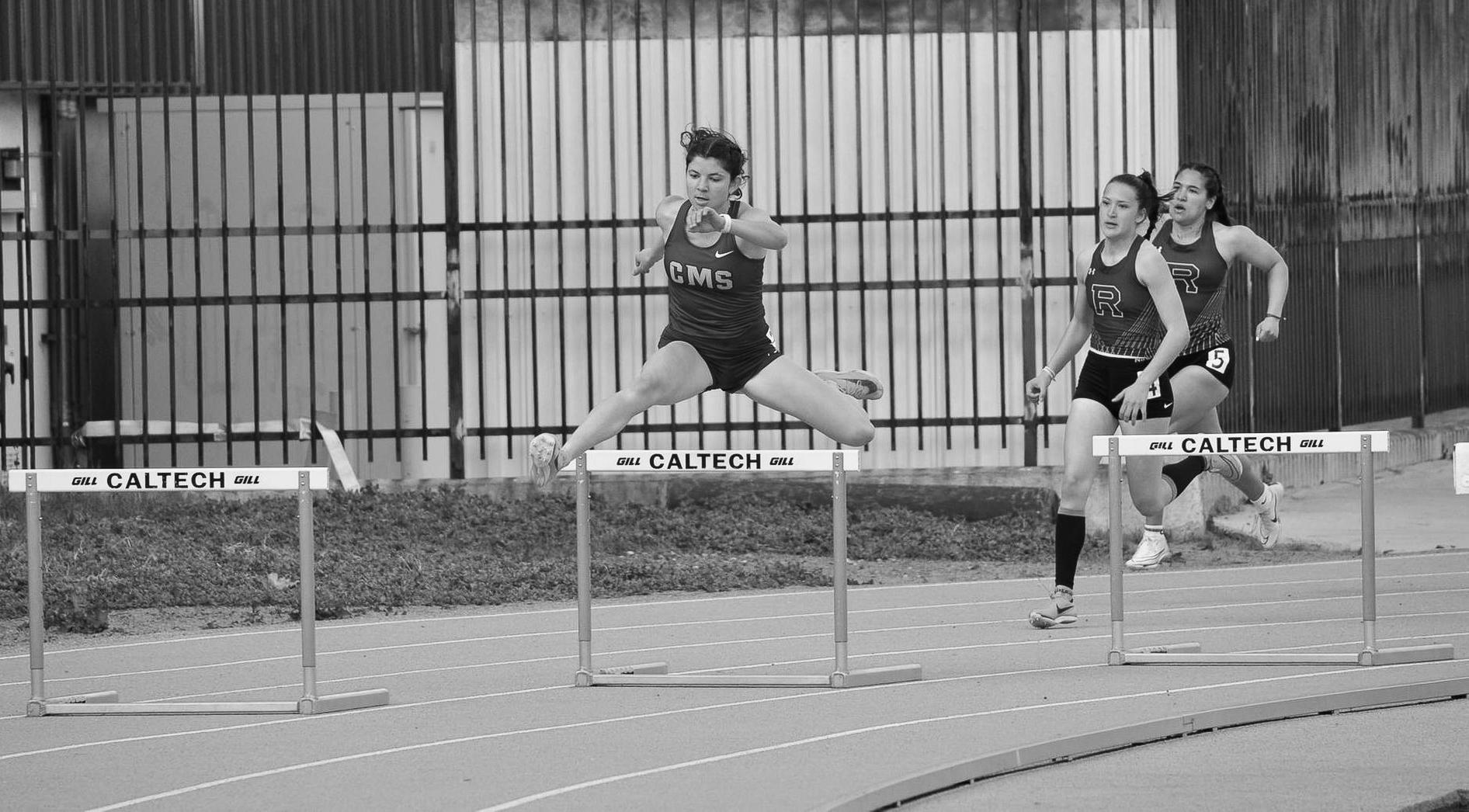
Caroline DelVecchio SC ’23, captain of the women’s team, has had individual success this season, being named the SCIAC Athlete of the Week for the second time on April 9. This distinction is a result of a win in the 400-meter hurdles at the Triton Invitational at UC San Diego on April 8, where she outran the second-place finisher by just 0.02 seconds. DelVecchio said that her team’s overall can-do attitude has inspired her to compete at the top of her level.
“We’re doing really well as a whole, [and] we actually have a lot of people this year that have never run before,” DelVecchio said. “They’re improving drastically, and it’s so fun watching them run and really be successful. We would definitely get the most-improved award and were looking to get the award [as champions] at SCIACs.”
DelVecchio suggests that many people, including other student-athletes, often underestimate the difficulty of the sport. She wishes more people understood the strain that running and doing field events puts on the athletes’ bodies.
“We have a teammate who also plays volleyball, and she joined the track team this year having never run track before,” DelVecchio said. “She always says that she never expected [running track] to be as hard as it is, so that is kind of validating. It would be nice for people to understand what we put ourselves through.” Because the men’s and women’s teams practice and compete alongside each other, thrower Carly Kirsch CM ’24 says that the team environment is one that promotes support and unity and helps these student athletes feel less alone in their experience as athletes of the sport. The two teams combined house over 130 student-athletes from all three schools, which high-
lights the uniqueness of having student-athletes from three colleges.
“While you’re definitely closest with your event group, everyone knows that we’re all still part of one big team and we really do try to support each other at meets,” Kirsch said. “My event consists of majority Mudders, and we definitely play on the [school] stereotypes a little bit and they joke around with us. Sometimes they’ll critique us and be like, ‘if you threw the hammer this many degrees higher, it would have gone this much farther.’ It’s such a great aspect of the team to be able to have that vibe.”
For DelVecchio, being part of a big team and having the opportunity to form relationships that she
feels she wouldn’t have otherwise makes the struggles and the commitment of being a student athlete –– particularly a track athlete ––worth it.
“Obviously I like running ––that’s why I do track –– but the part that brings me the most joy is running with my friends and having that support system,” DelVecchio said. “I don’t think that I would have stayed here if I didn’t have the track team. When I’m at practice, I’m running hard and working and I’m focused, but I am also spending time with some of my closest friends, and I would not trade that for the world.”
The Stags and the Athenas are set to finish off their regular season at the SCIAC Championships on April 29 and April 30 at La Verne.
‘Joy in the water’: BIpoC Surf trips provide students with the opportunity to reclaim surfing
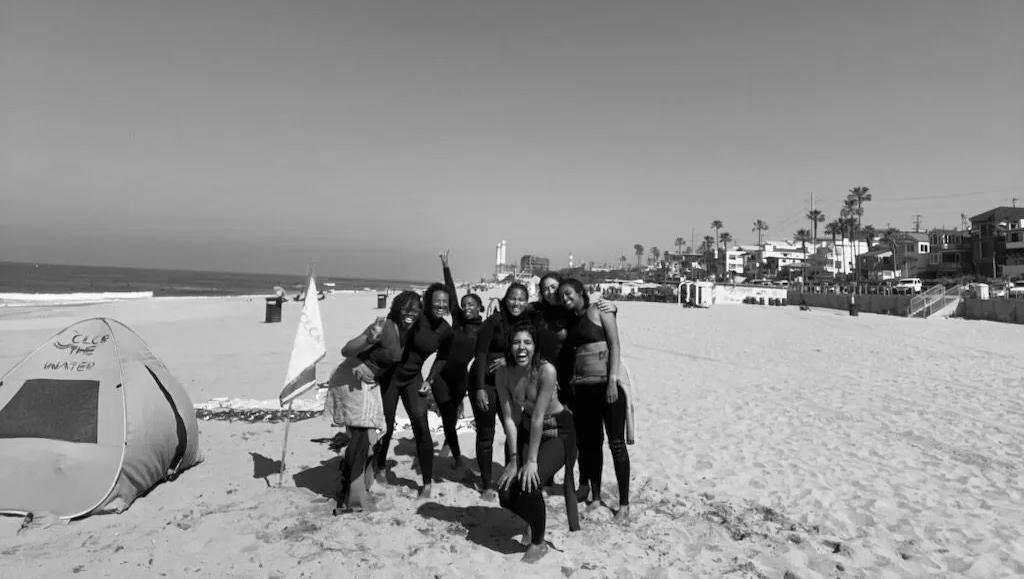
Floating on her surfboard in the ocean, 40-plus miles from Claremont, Aditi Madhok PZ ’23 finds joy in her “maritime escape,” describing it as a “hammock in the water.”
Madhok has been organizing surf trips for BIPOC students this year in collaboration with Color the Water — a nonprofit organization dedicated to providing a space for BIPOC to enjoy surfing in Los Angeles County. On campus, Madhok partners with Pitzer College’s Womxn of Color Collective (WCC) and Pitzer Outdoor Adventures (POA) to advertise the trips. She said she appreciates the organization’s dedication to increasing accessibility in surfing.
“They really support collective liberation and anti-racism and joy in the water,” Madhok said. “They’re focused on their surf lessons to be tackling anxiety and [building] intergenerational resilience and drawing from the origins of surfing … their mission is really just to foster joy in the water and to have fun, whether you catch a wave or not.”
Madhok said her passion for surfing started her first year at Pitzer. She said she previously had limited experience in the outdoors.
“I first tried surfing at my orientation trip at Pitzer,” she said. “I thought it was really cool that Pitzer does [trips like that], especially in the outdoors. I didn’t really grow up doing summer camps or backpacking or anything like that.”
Madhok said she felt out of place on that first trip but gradually grew to feel more comfortable surfing and wanted to spread the opportunity to engage in outdoor activities to other BIPOC. “When I became orientation trip leader, I got [assigned] surfing, but then the pandemic happened, so I didn’t get to facilitate that,” she said. “I had been really excited too because I was going to get to be with another woman of color … that was where [my inspiration] first started.”
Madhok began researching surfing organizations that engaged in BIPOC accessibility. She found Color the Water and began organizing Sunday morning surfing trips in collaboration with them. On top of the free surfing lessons they provide, Madhok said working with them has been a
great opportunity to engage in the broader context of racial and social justice movements.

“Color the Water started during the pandemic. It’s a nonprofit that started with doing [Black Lives Matter] PaddleOuts, [where] they paddled out in support of racial justice,” Madhok said.
Madhok said that through Color the Water she learned more about the history of surfing and its roots in BIPOC cultures.
“I remember one of the first things they said in the surf lesson we went to with other women of color was that the first recorded surfing was … in Ghana,” Madhok said. “It was really special to hear [from them] how surfing culture has also been erased and dominated by certain community members even though it has a huge presence in Hawaii and Indigenous communities … so I think that
kind of knowledge and history was something important to unpack.”
First-year Clarissa Aquino PZ ’26, who attended the trips this year, said she grew up swimming and playing water polo but had not tried surfing before the trips.
“I think that most BIPOC don’t really have the opportunity to go surfing,” Aquino said. “It’s very comforting and assuring to be able to go surfing with each other. We’re all learning together and it just feels like a safe place with no judgment. I think these trips fulfill a longing within us to do an activity that we’ve only ever really dreamed about doing.”
Corrie Waters PZ ’26, who also attended the trips this year, said she appreciated the opportunity to make new friends on the trips.
“Being Black myself, I don’t really think I’ve ever experienced all-Black surfing or just seen that in my life, so it’s filled me with joy, the times that I’ve been,” Waters said.
Waters said that the trips provide her with a safe space, something she said she feels she doesn’t get very much at a predominantly white institution.
“[I enjoy being able to] immerse myself within nature and outdoors experiences and being able to let that guard down that I have to sometimes put up while being in all-white spaces, which I often am at the Claremont Colleges,” Waters said. “I think this is a really special place that should be protected and continued to have
[here] and made as accessible as possible for people.”
Madhok said that as a senior, it is challenging to figure out how to keep the trips running after she graduates. She said she has to think about how to best collaborate between the organizations she works with — POA, WCC and Color the Water — so that all are contributing in their proper capacities and each organization’s needs are met. She encouraged 5C students to look for ways they can support Color the Water so that the surf trips can continue to happen in collaboration with them.
“If students would be interested in donating to Color the Water, that really helps. They really look for ways to support the community,” Madhok said.
She said she also emphasized that everyone should be more conscious of the land they are occupying, especially when working in outdoor recreation.
“I think it’s important to be continuously mindful of outdoor accessibility and relationships to the land and nature,” Madhok said. “Obviously, Southern California belongs to the Tongva people, and the more initiatives, whether it looks like BIPOC surfing or not, we can facilitate, the better. Whether it’s outdoor recreation or sports, [or] anything that honors the people who continue to live here. If we can get more initiatives that can ensure accessibility for a community of diverse backgrounds that don’t normally get to experience this at the 5Cs and beyond, that would be awesome.”
pAGE 12 April 21, 2023 Sport S
Caroline DelVecchio SC ’23 during her victory in the 400-meter hurdles, a race she won by just 0.02 seconds during the Triton invitational at UC San Diego on April 8.
COUrTESY: CMS ATHlETiCS
AMALIA KOCH
COUrTESY: ADiTi MADHOK pZ ’23
Students gather to pose for a photo during one of the surf trips organized by Aditi Madhok pZ ’23 for 5C BipOC students.





























































